Australia Post Travel Platinum Mastercard®
A prepaid travel card with 11 currencies to load from, giving you confidence when spending overseas.
- About Australia Post Travel Platinum Mastercard
- Fees & limits
- Get started
- Support & FAQs

The ideal prepaid card for overseas travel

Travel smarter with our Australia Post Travel Platinum Mastercard, a reloadable, multi-currency prepaid card that’s accepted wherever Mastercard is, worldwide 1 . Easily swipe or tap in-store, use online and withdraw money from ATMs 2 .
Load up to 11 currencies. Easily switch between USD, EUR, GBP, NZD, THB, CAD, HKD, JPY, SGD, AED and AUD on your travels.
Lock in your exchange rates. Know exactly how much you have to spend online or in-store with locked-in exchange rates 3 .
Travel safely. With no link to your bank account and Mastercard’s Zero Liability 4 protection against fraud and other unauthorised transactions.
Total control. Manage and load your prepaid travel money card on the go via ‘ My Account ’ or the Australia Post Travel Platinum Mastercard app.
24/7 global assistance. Card lost or stolen? Call for a replacement anytime. You may also be eligible for emergency funds assistance 5 .
Managing your travel money just got easier
Our Australia Post Travel Platinum Mastercard app makes managing your travel money faster and easier. Check your balance, reload in-app, track your spending and switch between currencies.
Mastercard Prepaid Management Services Australia Pty Ltd (ABN 47 145 452 044, AFSL 386837) arranges for the issue of the Australia Post Travel Platinum Mastercard in conjunction with the issuer, EML Payment Solutions Limited ('EML') ABN 30 131 436 532 , AFSL 404131. Australian Postal Corporation (ABN 28 864 970 579, AR No. 338646), the card distributor, acts as an Authorised Representative of Australia Post Services Pty Ltd (ABN 67 002 599 340, AFSL 457551). You should consider the Australia Post Travel Platinum Mastercard Product Disclosure Statement (PDF 248kB) and Financial Services Guide (PDF 72kB) before deciding to acquire the product. Any advice does not take into account your personal needs, financial circumstances or objectives and you should consider if it is appropriate for you. Mastercard® is a registered trademark, and the circles design is a trademark of Mastercard International Incorporated.
View the Target Market Determination (PDF 88kB) for this product.
If you click on links to Australia Post Travel Platinum Mastercard you will be leaving the Australia Post site and be directed to a third-party site to place your order and complete your purchase. Please see the terms and conditions of the third-party site for further details.
1 The ATMs and POS terminals are not owned or operated by Australia Post, the Issuer or Mastercard Prepaid Management Services and Australia Post, the Issuer and Mastercard Prepaid Management Services are not responsible for ensuring that they will accept the Card
2 Some ATM operators may charge their own fees and set their own limits.
3 Lock in your exchange rates means the exchange rate is locked in for the initial load only. The exchange rates for subsequent reloads will be set at the prevailing exchange rate at the time of the transaction.
4 Further information relating to Zero Liability card protection can be found at the Mastercard website .
5 T&Cs apply. Customers must contact Customer Service to report lost or stolen cards. Emergency cash can be arranged up to the balance of your Australia Post Everyday Mastercard, subject to availability of funds at the approved agent location.
For a full list of Fees & Limits, refer to the Product Disclosure Statement (PDF 258kB) .
Mastercard Prepaid Management Services Australia Pty Ltd (ABN 47 145 452 044, AFSL 386837) arranges for the issue of the Australia Post Travel Platinum Mastercard in conjunction with the issuer, EML Payment Solutions Limited ('EML') ABN 30 131 436 532 , AFSL 404131. Australian Postal Corporation (ABN 28 864 970 579, AR No. 338646), the card distributor, acts as an Authorised Representative of Australia Post Services Pty Ltd (ABN 67 002 599 340, AFSL 457551). You should consider the Australia Post Travel Platinum Mastercard Product Disclosure Statement (PDF 248kB) and Financial Services Guide (PDF 72kB) before deciding to acquire the product. Any advice does not take into account your personal needs, financial circumstances or objectives and you should consider if it is appropriate for you. Mastercard® is a registered trademark, and the circles design is a trademark of Mastercard International Incorporated.
Travel smarter with our prepaid travel money card
Buy your Australia Post Travel Platinum Mastercard® at a participating Post Office or online .
Register / Activate
Register your prepaid travel money card online.
If you purchased your card online, you’ll need to activate it.

Load your card anytime online through ' My Account ', the Australia Post Travel Platinum Mastercard® app or at any participating Post Office .
Use your card wherever Mastercard is accepted 1 .
1 The ATMs and POS terminals are not owned or operated by Australia Post, the Issuer or Mastercard Prepaid Management Services and Australia Post, the Issuer and Mastercard Prepaid Management Services are not responsible for ensuring that they will accept the Card.
More information
- Product Disclosure Statement (PDF 339kB)
- Financial Services Guide (PDF 72kB)
- Target Market Determination (PDF 88kB)
Can't find an answer below? Call Card Services on 1800 549 718 within Australia or +44 207 649 9404 internationally for help 24/7.
If you have a transaction on your card that doesn't seem right, download the disputed transaction form .
Frequently asked questions
Australia Post acknowledges the Traditional Custodians of the land on which we operate, live and gather as a team. We recognise their continuing connection to land, water and community. We pay respect to Elders past, present and emerging.
- Join CHOICE
Travel money cards with the lowest fees
We look at seven travel money cards from the big banks and airlines..
Prepaid travel money cards are offered by major banks, airlines and foreign exchange retailers like Travelex. Before travelling overseas, you load money into the card account, which locks in the exchange rate for foreign currencies at that time.
You can then use the card for purchases and cash withdrawals just like a debit or credit card, usually wherever Visa and Mastercard are accepted.
You can reload money on-the-go via an app or website, and if the card is lost or stolen, it can be replaced (usually at no cost to you).
Prepaid travel money cards also give you assurance that you're not handing the details of your everyday banking account to merchants you're not familiar with, and they provide easy access to cash when you want some, says Peter Marshall, head of research at money comparison website Mozo .
CHOICE tip: Travel money cards are best for longer trips. They're usually not worth your while if you're only taking a short trip, as some have closure, cash out and inactivity fees.
Travel money card fees
A major difference between prepaid travel cards and debit or credit cards is their fees. Some costs aren't immediately apparent, such as hefty margins built into the exchange rates.
And although fees have come down since we looked at these cards two years ago, you still need to watch out for:
- fees to load the card – either a percentage of the total or a flat fee
- ATM withdrawal fees
- a cross currency fee or margin when you use the card in a currency you haven't preloaded
- further fees if you close the account or haven't used the card for a period of time.
Travel money card with the lowest fees and best exchange rate
Westpac worldwide wallet.
Westpac closed its Global Currency Card in July 2021 and offers its new card in partnership with Mastercard. It's also available from Bank of Melbourne and BankSA.
Currencies: AUD, USD, NZD, EUR, GBP, SGD, THB, JPY, HKD, CAD, ZAR.
Key features:
- No loading, reloading, closing or inactivity fees.
- Free to use it in network ATMs in Australia and partner ATMs overseas in a range of countries including the UK, US and New Zealand.
- A charge applies at non-Westpac and non-partner ATMs in Australia and overseas.
- Best exchange rates for the US dollar, the Euro and GBP in our comparison.*
- The only card that lets you preload the South African rand.
Other travel money cards
Next to the Westpac Worldwide Wallet, there are six other travel money cards available.
Australia Post Travel Platinum Mastercard
Available online or at post offices.
Currencies : AUD, USD, NZD, EUR, GBP, SGD, THB, JPY, HKD, CAD, AED.
- Fee to reload the card via BPay, debit card or instore, but free via online bank transfer.
- Closure fee.
- Fees for ATM withdrawals in Australia and overseas.
Cash Passport Platinum Mastercard
It's issued by Heritage Bank and is available online and from a number of smaller banks and credit unions (like Bendigo Bank and Bank of Queensland) as well as travel agents.
- Fee to reload with a debit card or instore, but free via BPay.
CommBank Travel Money Card
CommBank Travel Money Card (Visa)
As NAB and ANZ have closed their travel money cards, this is the only other travel money card available from a major bank. This card has the largest variety of currencies that can be preloaded.
Currencies : AUD, USD, NZD, EUR, GBP, SGD, THB, JPY, HKD, CAD, AED, VND, CNY.
- Fee if you make a purchase with currencies not preloaded.
- Fee for withdrawals at overseas ATMs.
Qantas Travel Money Card
Qantas Travel Money Card (Mastercard)
The only travel money card offering from an airline. It can be added as a feature to your Qantas Frequent Flyer card, so you don't need a dedicated card, and you can earn points using it.
- Free to reload via bank transfer or BPay, but there's a reload fee if using debit card.
Travelex Money Card
Travelex Money Card (Mastercard)
Travelex is an international foreign exchange retailer. In Australia, it operates more than 140 stores at major airports and shopping centres, across CBDs and in the suburbs. It was the card with the best exchange rate for New Zealand dollars.*
Currencies : AUD, USD, NZD, EUR, GBP, SGD, THB, JPY, HKD, CAD.
Fees :
- Load fee instore, but free via Travelex website or app.
- Reload fee instore or via BPay, but free via Travelex website or app.
- Closure fee and monthly inactivity fee (if not used for 12 months).
Travel Money Oz Currency Pass
Travel Money Oz Currency Pass (Mastercard)
The Travel Money Group is owned by Flight Centre and is a foreign exchange retailer.
- Reloading the card via an online bank transfer or instore is free, but there's a fee if you reload via BPay, debit card or credit card.
- Cash out (closure) fee.
Travel money card tips
- Make sure the card allows the currencies you'll need, and also consider stopovers. For example, the South African rand is only supported by the Westpac card.
- Try to load your card with the right currencies and amounts on days with good exchange rates.
- Make sure you know how to reload your card if you run out of funds while overseas.
- It may be more convenient to choose a card that has an app that can be linked to your bank account.
- Avoid loading more money than you'll need as there may be fees and exchange rate margins to get the unused money back.
- Remember to cancel the card once you're finished your trip, especially if it has inactivity fees.
- Be mindful that you still may need a credit card, as travel money cards may not be accepted as security for hotels and car rental agencies.
Stock images: Getty, unless otherwise stated.
Join the conversation
To share your thoughts or ask a question, visit the CHOICE Community forum.
- United States
- United Kingdom
The best travel money cards for Australian travellers
Compare prepaid travel cards, debit cards and credit cards to find the best option for your next overseas trip..
In this guide
Using your debit card overseas
Debit cards with no international transaction fees, best prepaid travel cards to load foreign currency, find a better travel money card, australian travel statistics, 1. new zealand, 2. indonesia.
- 4. The UK, Canary Islands & the Isle of Man
6. Thailand
8. singapore, 10. vietnam.
Travel Money Cards
What you need to know
- The most important features to compare are the foreign transaction fees, exchange rates and usability.
- If you want to withdraw cash, a prepaid travel card or debit card will likely be cheaper than a credit card.
- It is a good idea to have several travel money options in case of loss, damage or theft.
Debit cards allow you to spend the money you have in your bank account, instead of having to pre-load it like a prepaid travel card. There are some debit cards that don't charge any international transaction fees and even some that allow you to hold multiple currencies - like the HSBC Everyday Global Account .
Instead of a debit card, a prepaid card lets you load up on the currency you need before you get there. There are several options for this, but the right one for you will largely depend on the currency you're going to be using.
We've looked at the top 10 most popular travel destinations for Aussies based on the Australian Bureau of Statistics overseas departure and arrivals data and rounded up the most relevant travel cards you could use in each location. From the rolling hills of New Zealand to the bustling streets of China, read on for the travel card tips you'll need for your next holiday.
Australia is a nation of travellers. According to the Australian Bureau of Statistics, there were 8,337,080 resident returns from overseas for the year 2022 - 2023. The most popular reason we travel is for a holiday, and the median trip duration is 15 days.

The land of towering snow-capped mountains, crystal blue lakes and hobbits and elves often tops Australia's list of favourite travel destinations. Conveniently, most Australian prepaid travel cards support New Zealand dollars.
See our New Zealand travel money guide for more tips to help you prep for your trip over the Tasman.
Aussies love the tropical climate, beaches and poolsides of Indonesia. Despite our close proximity to Indonesia and Australia's reputation for frequenting tourist destinations such as Bali, no Australian travel cards currently support Indonesian rupiah.
However, as Visa and Mastercard are accepted in Indonesia, you can still use an Australian travel card when you're there. You can find travel cards that don't charge a currency conversion fee when you spend in an unsupported currency.
Browse our Indonesia travel money guide for more travel money options.
The land of stars and stripes also has a soft spot in the heart of Australian travellers. So, it's probably no surprise that most Australian prepaid cards support US dollars.
See our US guide for the best travel money options for your next trip to the states.
4. The UK, Canary Islands & the Isle of Man
If you're making a Eurotrip to the UK, you'll be glad to know that most Australian prepaid travel cards support the pound sterling.
Use our UK travel guide for everything you need to plan your next trip to the UK.
The Indian rupee isn't supported by any Australian travel cards. So, if you're travelling to the hustle and bustle of India, you might want to look for travel cards that don't charge any currency conversion fees when spending in an unsupported currency.
Thailand is a popular holiday destination for many Aussies seeking sunshine and rich culture, so it's lucky that quite a few Australian travel cards support the Thai baht.
Use our Thailand travel money guide to research more travel money options for your trip.
While the white sands and crystal blue waters of Fiji are a favourite for Aussie travellers, no prepaid travel cards currently support the Fijian dollar. However, as Mastercard and Visa are widely accepted in Fiji, there are still a few options available for holidaymakers drawn to this island oasis.
See our Fiji guide for more travel money tips and tricks.
If you're taking a trip to the Garden City, there are a few travel card options to choose from.
You can find more travel money options for your trip to Singapore with this guide .
Whether you want to bask in the beauty of cherry blossom season or tear up the snowy slopes, there are plenty of travel card options if you're planning a trip to Japan.
See our Japan guide for more travel money tips for your next holiday.
A land of beautiful beaches, Buddhist pagodas and bustling cities, Vietnam makes the list of Australia's most popular travel destination. If you're planning a trip and want to spend in Vietnamese dong, there are travel card options to choose from.
You can find more travel money options for your trip to Vietnam with this guide .
While there's no single best travel money card out there, it's easier to narrow down your search when you know which cards support the local currency you'll be spending in on your trip. Once you've done this, look for any issue fees, ATM withdrawal fees and loading costs to help compare your travel money options and pick the right travel card companion for you.
Latest travel headlines
- Can travel insurance cover conflicts abroad?
Sally McMullen
Sally McMullen was a creative content producer at Finder. Sally wrote about credit cards for almost 5 years, authoring almost 900 articles on Finder alone. She has also been published in Yahoo Finance, Dynamic Business, Financy and Mamamia, as well as Music Feeds and Rolling Stone. Sally has a Bachelor of Communication and Media Studies majoring in Journalism (Hons) from the University of Wollongong.
More guides on Finder
The Wise Travel Money Card supports over 40 currencies, with free loading by bank transfer and an instant, virtual card. Here’s how its other features compare.
Revolut offers virtual and physical Visa cards, support for over 30 currencies and other travel perks – plus 3-month Premium trial with this offer.
Use finder's interactive world map to learn about variations in beer prices globally. Find out where in the world you'd pay a whopping $15.10 for a pint.
Discover the travel money options available for young people and how to prepare for a trip overseas.
Want to avoid fees and charges when using your card overseas? This guide explains the most common pitfalls when using travel cards.
This guide explains how you can get back any leftover funds from your travel money card after your trip.
Use this guide to understand foreign currency exchange and discover how to get the best deal.
Spend in up to 13 major currencies, lock in exchange rates and manage your account with the CommBank app when you use the Commonwealth Bank Travel Money Card.
Spend in 11 currencies wherever Mastercard is accepted and save on currency conversion fees with the Cash Passport Platinum Mastercard.
Ask a Question
Click here to cancel reply.
You are about to post a question on finder.com.au:
- Do not enter personal information (eg. surname, phone number, bank details) as your question will be made public
- finder.com.au is a financial comparison and information service, not a bank or product provider
- We cannot provide you with personal advice or recommendations
- Your answer might already be waiting – check previous questions below to see if yours has already been asked
11 Responses
I am going on a cruise with stops in India, Singapore, Dubai and Sri Lanka. Apart from getting cash what is the best way to take money there? I will only be in Sri Lanka for one day.
Hello there Ian,
Thank you for your inquiry.
Like the page you’re on, you have travel card alternatives for Singapore and India. However, India does not support Australian travel cards, but rather you can look at your travel card choices that don’t charge currency conversion fees.
In Dubai, you may begin looking at your travel card.
In Sri Lanka, Their Government has tight control over the national money and there are strict points of confinement on the measure of rupees you can get in and out of the nation. Aside from cash, you may look at your prepaid travel cards, debit or credit card choices on our page for Travel guide in Sri Lanka.
You may likewise jump at the chance to consider a Debit Card or Credit Card with low or no currency conversion fees.
I hope this information helped.
Cheers, Asia
Travelling to Mexico and Cuba and don’t know whether there is any card better than a Westpac Global Currency Card all things considered.
Thank you for visiting Finder.
For options in getting the most suitable travel money card for you, you may want to visit our travel money option for Mexico as well as our travel money guide for Cuba. From there you may compare cards and select which one would suit your needs. Once you have chosen a particular card, you may then click on the “Go to site” button and you will be redirected to the bank’s website where you can proceed with your application or get in touch with their representatives for further assistance.
Please ensure you review the relevant Product Disclosure Statements/Terms and Conditions before applying.
Cheers, Joanne
What about Peruvian Soles? Or Chilean Pesos? Do I have to put in USD first?
Thanks for your question.
Currently, prepaid travel money cards do not support the currencies of South American countries. You would have to load them with Australian dollars and withdraw the local currencies such as nuevo sol and peso. However, this will attract overseas ATM fees and currency conversion fees.
If you wish to avoid these fees you can use debit or credit cards. Moreover, you can consider a travel card with no currency conversion fees. Check out our Travel Money Guide to Peru to compare your options. You may also check your travel money options for South America.
Before applying, please ensure that you read through the relevant Product Disclosure Statements/Terms and Conditions when comparing your options before making a decision on whether it is right for you. You can also contact the provider if you have specific questions.
Cheers, Liezl
Travelling to Bali with a Qantas Cash card. I understand I can’t load it with rupiah, however can use it where Mastercard accepted. I’m not clear though on what the currency conversion fee is. Above it says that you can “avoid currency conversion fees when spending Indonesian rupiah with this card.” However you can’t load Rupiah in the card. Can you explain further please?
Hello Jacqui,
The currency conversion fee is when you load Australian dollars on your card and then convert them to Rupiah while you’re traveling in Indonesia. In this case, you are simply converting the currency on a “as per needed basis”, Qantas daily rate for the currency you’re spending in will apply. You can use their currency conversion tool on the website to check the exchange rate daily.
If in case you are interested, please explore different travel money options in Indonesia .
Please take time to download the Product Disclosure Statement of this product to know more about the terminologies and fees associated with use.
Hope this clarifies.
Cheers, Jonathan
What about. Europe comparison for travel cards?
Hi Suzanna,
Thanks for your inquiry.
Here is the page where you can compare Travel Cards for Europe – https://www.finder.com.au/travel-money/europe . It also has a comparison for Travel Credit Cards and Travel Debit Cards.
Hope this information helped.
Cheers, Rench
Hi Suzanne,
You may be interested to check the available option/s for travel cards in Europe on our website. Check that page and you will also find more details about how you use travel money cards in Europe.
I hope this information has helped.
cheers, Harold
How likely would you be to recommend finder to a friend or colleague?
Our goal is to create the best possible product, and your thoughts, ideas and suggestions play a major role in helping us identify opportunities to improve.
Important information about this website
Advertiser disclosure.
finder.com.au is one of Australia's leading comparison websites. We are committed to our readers and stands by our editorial principles
We try to take an open and transparent approach and provide a broad-based comparison service. However, you should be aware that while we are an independently owned service, our comparison service does not include all providers or all products available in the market.
Some product issuers may provide products or offer services through multiple brands, associated companies or different labeling arrangements. This can make it difficult for consumers to compare alternatives or identify the companies behind the products. However, we aim to provide information to enable consumers to understand these issues.
How we make money
We make money by featuring products on our site. Compensation received from the providers featured on our site can influence which products we write about as well as where and how products appear on our page, but the order or placement of these products does not influence our assessment or opinions of them, nor is it an endorsement or recommendation for them.
Products marked as 'Top Pick', 'Promoted' or 'Advertisement' are prominently displayed either as a result of a commercial advertising arrangement or to highlight a particular product, provider or feature. Finder may receive remuneration from the Provider if you click on the related link, purchase or enquire about the product. Finder's decision to show a 'promoted' product is neither a recommendation that the product is appropriate for you nor an indication that the product is the best in its category. We encourage you to use the tools and information we provide to compare your options.
Where our site links to particular products or displays 'Go to site' buttons, we may receive a commission, referral fee or payment when you click on those buttons or apply for a product. You can learn more about how we make money .
Sorting and Ranking Products
When products are grouped in a table or list, the order in which they are initially sorted may be influenced by a range of factors including price, fees and discounts; commercial partnerships; product features; and brand popularity. We provide tools so you can sort and filter these lists to highlight features that matter to you.
Terms of Service and Privacy Policy
Please read our website terms of use and privacy policy for more information about our services and our approach to privacy.
- Investing & super
- Institutional
- CommBank Yello
- NetBank log on
- CommBiz log on
- CommSec log on
Help & support
Popular searches
Travel insurance
Foreign exchange calculator
Discharge/ Refinance authority form
Activate a CommBank card
Cardless cash
Interest rates & fees
Travel / Travel Money Card
Travel Money Card
Lock in exchange rates and load up to 13 currencies on one account to easily access your money while you’re travelling.
Features & benefits
$0 card issue fee.
Order a Travel Money Card for free in branch or online (search 'Travel Money Card' in the CommBank app or log into NetBank ).
Lock in exchange rates
Load up to 13 currencies on one card before your trip, so you know how much you have to spend, no matter how the Australian Dollar moves.

Spend anywhere in the world
Shop online, in-store, or over the phone wherever Visa is accepted, plus get access to Visa ® travel offers .
Easily manage your travel budget
Manage your holiday money and track your spending via the CommBank app or NetBank.

Your purchases, covered
Lost or stolen personal belongings? We may be able to cover the cost to repair or replace them up to 90 days after purchase. 2
Extra card security
Lost, misplaced or stolen card? Lock it and report it in the CommBank app or NetBank.
- Currency converter
Exchange rates
Load up to 13 currencies on one account
Lock in exchange rates and load up to 13 currencies easily on one account – wherever you are in the world – through NetBank or the CommBank app:
- United States Dollars (USD)
- Euros (EUR)
- Great British pounds (GBP)
- Australian Dollars (AUD)
- Japanese Yen (JPY)
- New Zealand Dollars (NZD)
- Hong Kong Dollars (HKD)
- Canadian Dollars (CAD)
- Singapore Dollars (SGD)
- Thai Baht (THB)
- Vietnamese Dong (VND)
- Chinese Renminbi (CNY)
- Emirati Dirham (AED)
No load or reload fees
You can load up to 13 currencies on your Travel Money Card with no load or reload fees. The exchange rate is the CommBank Retail Foreign Exchange Rate at the time of the conversion.
When you’re ready to pay for something, we will always try to complete the transaction for the country you are in. Make sure you have enough of the correct currency for the country you’re in on your card to avoid additional fees. If you don’t have enough of the local currency, we’ll use the next available currency instead, so long as there’s enough of it loaded on your card.
If you load multiple currencies on your Travel Money Card, you can change the order (the next available currency) anytime online.

Rates & fees
See all fees and charges
Who can apply
To get your Travel Money Card, you’ll need to:
- Be at least 14 years old;
- Be registered to use NetBank, or register online New to CommBank? Sign up to NetBank at your nearest branch ;
- Provide a valid email address; and
- Have an Australian residential address
How to apply
Before your trip.
- Order a Travel Money Card in the CommBank app (search 'Travel Money Card'), NetBank , or at your nearest branch .
- Load at least AUD 50 or the foreign currency equivalent to get started
- Once you’ve got your card, activate and set your PIN online in NetBank, or under Cards in the CommBank app
- Lock-in the exchange rate by loading currency on your card in NetBank or the CommBank app
How it works
During your trip.
- The local currency will be automatically applied when you pay for something, as long as it’s loaded on your card and you have sufficient funds
- Reload in real time , fee-free if your balance gets low
- Stick to daily transaction limits
- The maximum value of purchases per day is unlimited, however no more than your available balance
- The maximum amount you can withdraw from ATMs per day is AUD 2,500 or the foreign currency equivalent. Keep in mind most ATM operators have a limit on how much you can withdraw from an ATM per transaction
- The maximum amount for over-the-counter withdrawals per day is AUD 2,500 or the foreign currency equivalent.
When you’re home
- Got leftover currency? Exchange it for another currency or back into your CommBank account from NetBank or the CommBank app
- Top up your Travel Money Card (it’s valid for 4 years) in preparation for your next trip
- Donate your foreign (and local) currency to any CommBank or Bankwest branch and every cent will go to UNICEF
- How to manage your Travel Money Card
You’ve got your new card – here’s how to get the most out of it.
Find detailed info on getting started, loading and reloading currencies, setting a currency order, checking your balance and tracking your spend. Plus, info on Purchase Security Insurance Cover and access to Visa ® travel offers .
Manage your Travel Money Card

Need foreign cash? Have it ready before you travel
If you’re a CommBank customer, you can buy or sell up to 9 foreign currencies at selected CommBank branches in exchange for Australian Dollars.
You can also order foreign cash in over 30 currencies online – even if you’re not a CommBank customer.
Discover Foreign Cash

Planning an overseas trip?
Discover travel tips to help make the most of your European summer holiday.
See travel tips

Emergency support & tools
What to do if you’ve lost your card or it’s stolen.
If you’ve lost your Travel Money Card, or you think it might’ve been stolen, we can have an emergency replacement card sent to you anywhere in the world.
You may also be eligible for an Emergency Cash Advance, giving you access to cash within 24-48 hours (often on the same day).
Call us in an emergency on:
- 1300 660 700 within Australia
- +61 2 9999 3283 from overseas (reverse charges accepted).
When calling from overseas using your mobile, standard roaming charges may apply. To avoid roaming charges, call the international operator in the country you’re in from a landline and give them our reverse charges number +61 2 9999 3283.
Tools & calculators
- Saving calculator
- Budget planner
- Managing multiple currencies on your Travel Money Card
- Travelling overseas: 10-step money checklist
- Beginners guide to exchange rates
- Online banking while overseas
- Planning an overseas holiday
We can help
Your questions answered
Get in touch
Visit your nearest branch
Things you should know
1 The cash withdrawal fee will not apply to cash withdrawals made in Australia.
2 For more information relating to the complimentary Purchase Security Insurance refer to Travel Money Card Complimentary Insurance Information Booklet (PDF) .
As this advice has been prepared without considering your objectives, financial situation or needs, you should before acting on this advice, consider its appropriateness to your circumstances. The Product Disclosure Statement and Conditions of Use (PDF) issued by Commonwealth Bank of Australia ABN 48 123 123 124 for Travel Money Card should be considered before making any decision about this product. View our Financial Services Guide (PDF) .
To raise a dispute related to your Travel Money Card please complete this form for transactions (PDF) or this form for ATM disputes (PDF) .
Any withdrawal or balance enquiry fee will come from the currency for which you are using your card. If this currency is not loaded on your card, the fee will be taken from the first (or sole) currency loaded on your card. Any SMS balance alert fee will come from the first (or sole) currency loaded on your card.
The target market for this product will be found within the product’s Target Market Determination, available here .

- Travel Money Card
Get our best rate on the award winning Travelex Money Card
Buy currency, top up card.
Rate last updated Friday, 19 April 2024 1:06:13 PM AEST. Please note that these are the Travelex online sell rates.
[fromExchangeAmount] [fromCurrencyCode] Australian Dollar
[toExchangeAmount] [toCurrencyCode] [toCurrencyName]
Enter the card number of the Prepaid Card you would like to top up. The number of the Prepaid Card you are topping up must be the Primary Card Number and must have been originally purchased from Travelex.
Card number confirmed
Select the currency you would like to top up to your card
Enter how much you'd like to top up, either in Australian Dollars, or in the foreign currency amount for the currency you have selected.
This section is optional on mobile
E!am commodo accumsan scelerisque. Quisque posuere laoreet lectus a elementum. Mauris euismod, lectus sed gravida dictum, magna orci iaculis ligula, quis blandit lorem enim at magna.
Get Dollars on Us with the Travelex Money Card!
This offer is available online, in-store and via the Travelex Money App.
The Travelex Money Card
Travel Card Exchange Rates & Currencies
Choose your currency, $0 currency conversion fee when spending a currency not on your travel card:.
The below calculator is a handy tool to help you estimate the applicable exchange rate for your transaction 2 :
Spend Calculator
You can use this calculator to see what your spend would look like for your trip. It will help you estimate the applicable exchange rate for your transaction.
- Netherlands
- Vatican City
- Czech Republic
Get Dollars on Us!
Load more, save more with the travelex money card.
- Save up to AUD $240! View all available discounts codes here .
- Available online, in-store, or via the Travelex Money App. Ends 28 April at 11.59pm AEST. T&C Apply.
Save with the Travelex Money Card
$0 Eftpos Fees
$0 atm fees 1, $0 currency conversion fees ^, $0 online shopping fees*, $0 free delivery to your home, special offer, load aud on your travelex money card and save when spending in the below currencies.
- Free Online AUD Load and Top-Ups
- $0 International ATM Fees
Features and Benefits
UNLIMITED FREE overseas ATM withdrawals 1
Highly competitive exchange rates
NO fees when you buy online $0 Currency conversion fee ^
24/7 Global Assistance
Convenient Mobile App Download it here
Shop at millions of outlets wherever Mastercard is accepted and on international websites with the local currency
Buy online, collect in-store or get it delivered to your home (allow up to 7 days from when payment is received)
5 ☆ outstanding value award winning travel money card
Exclusive offers with Mastercard Priceless TM Cities
No account or membership required
How our Travel Card Works
Order your travel card.
Order your Travelex Money Card online or in-store (passport or driver's license required)
Get your travel card
Collect from a Travelex store or delivered FREE to your home (allow up to 7 days from when payment is received)
Download the App
Download the app from the Google Play and Apple App stores
Register for My Account
Simply activate your card by registering your account via the app or online
Manage and check your balance online and on your mobile
Exchange leftover currency
After your trip, exchange leftover money for another currency, transfer into your bank account or withdraw in-store or at an ATM.
Fees and Limits
NO fees online $0 Currency conversion fee ^
Withdraw daily up to AU$3,000 (or currency equivalent)
Maximum Card limit of AU$50,000
Free initial and replacement card
The following fees and limits apply. Fees and limits are subject to variation in accordance with the Terms and Conditions. Unless otherwise specified, all fees will be debited in AU$ Currency
If there are insufficient funds in AU$ Currency to pay such fees, then we will automatically deduct funds from other Currencies in the following order of priority: AU$, US$, EU€, GB£, NZ$, THB, CA$, HK$, JP¥, SG$.
• Online: FREE via travelex.com.au or the Travelex Money App • In-Store: FREE for loads of foreign currency (loads of Australian dollars (AUD) incur a fee of 1.1% of the amount or $15 whichever is greater).
• Online: FREE via travelex.com.au or the Travelex Money App • In-Store: FREE for top-ups of foreign currency (top-ups of AUD incur a fee of 1.1% of the amount or $15 whichever is greater). • BPAY: Top-ups not made via travelex.com.au or the Travelex Money App incur a fee of 1% of the amount. - MasterCard Biller Code: 184416 - Reference No: your 16 digit Travelex Money Card number - Funds will be allocated to your default currency. To check your default currency login to your account.
FREE (note: Some ATM operators may charge their own fees or set their own limits)
- Charged at the start of each month if you have not made any transactions on the card in the previous 12 months
- Unless your card is used again, or reloaded, this fee applies each month until the card is closed or the remaining card balance is less than the inactivity fee.
AU$4.00 per month
- Charged when you close your card or withdraw from your Card Fund. This fee is set and charged by Mastercard Prepaid.
- This is applied when you move your funds from one currency to another currency.
At the then applicable retail foreign exchange rate determined by us. We will notify you of the rate that will apply at the time you allocate your funds from one currency to another.
- Applied when a purchase or ATM withdrawal is conducted in a currency either not loaded or sufficient to complete the transaction and the cost is allocated against the currency/ies used to fund the transaction.
FREE* *The Spend Rate will apply to foreign exchange transactions in accordance with the Terms and Conditions.
AU$350 or currency equivalent AU$100 or currency equivalent
AU$50 or currency equivalent
The maximum amount you can load on the card at the time of the initial online purchase is AU$5,000 equivalent.
to a maximum of $10,050 per single top-up; and to a maximum of $10,050 top-up value over 24hrs; and to a maximum of $20,000 top-up value over 21 days.
AU$3,000 or currency equivalent
AU$15,000 or currency equivalent
Other Important Information
Please read the following information about your Travelex Money Card carefully:
- Your Travelex Money Card does not generate any interest or any other similar return. You do not earn interest on the amount standing to the credit of the Travelex Money Card Fund accessed by the card.
- Although the issuer of the card is an authorised deposit-taking institution in Australia, the Card is not a deposit account with the Issuer.
Important Information about Fees & Limits for loads/top ups made online:
- If you are making a purchase or topping up the Card online via www.travelex.com.au (i) the initial load and top up fee may differ to (but not be greater than) those contained in the “Fees and Limits Table” of this Product Disclosure Statement; and (ii) the limits may differ to those contained in the “Fees and Limits Table” of this Product Disclosure Statement. Travelex may also charge a card surcharge if you pay with a credit or debit card. Please refer to the relevant online terms and conditions available at www.travelex.com.au for details of the applicable fees and limits.
- AU$ cannot be loaded or topped up onto a card online via www.travelex.com.au
Terms & Conditions
Download the travelex travel money app.
Convenience on the go
- Top up your Travelex Money Card
- Check your balance
- Quick touch log in
The app requires Android 5.0 and up or iOS 10.0 or later. Compatible with iPhone, iPad and iPod touch.

Other Ways to Get Foreign Currency
All the easy options to access foreign currencies with travelex.

About Travelex Money Card online and in-store

- Travel Insurance
Discover more of the world with travel insurance by your side

All you need to know getting foreign cash with Travelex

Get foreign cash from an ATM in Australia

About Your Destination
Browse our Destination Guides
Historical Rates
Check out current and historical AUD to FX Travelex rates
Track Currency Rates
Receive an alert when your selected foreign currency has reached your desired rate
- Find a Store
Purchase cash, a Travelex Money Card or transfer money in-store
Travelex Travel Card Currency Information
Travel card faq links.
Getting Started
Using the Card
Topping up the Card
Travelex Money Card FAQ
You can only hold one card in your name at any one time.
Top-up via the Travelex website
Note that you must use your unique reference number when paying or the transfer may be delayed.
Top-up via the Travelex Money App
Move currencies on your card, instantly.
If you have AUD (or any other currency) already loaded on the card, you can move your funds to another currency within the Travelex Money App. Instant top-up!
Top-up in a Travelex store
Direct top-up via bpay:.
Top-ups not made via travelex.com.au or the Travelex Money App incur a fee of 1% of the amount. You must make payment using your own account.
MasterCard Biller Code: 184416 Reference No: your 16 digit Travelex Money Card number
Funds will be allocated to your default currency. To check your default currency login to your account. Top ups will generally take two business days to be processed however may take longer if the payment is not made before 2pm on a business day Australian Eastern Standard Time.
Yes, travel money cards come with a host of advantages that can save you money when travelling. These include the ability to load multiple currencies at a fixed and competitive exchange rate, and the capability to make purchases in-store, online, and at ATMs worldwide with no overseas ATM or withdrawal fees.
- Locking in fixed foreign currency exchange rates and avoiding foreign transaction fees before you travel
- The ability to load multiple currencies onto one card, similar to a travel debit card
- The ability to spend money conveniently and comfortably overseas
- No overseas ATM withdrawal fees
- No fees when making online purchases
- Travel money cards can be ordered online and collected in store next day (when paying by debit/credit card).
- Just walk in store. Cards purchased and loaded in-store are active and ready-to-use on the spot. We will automatically transfer funds between currencies complete your card transactions.
- Home delivery within 5-7 business days (from when payment is received).
Most common questions
The best travel money card for Australians is the one that caters to the currencies available at your destination, removes ATM withdrawal and foreign purchase fees, and has the best exchange rate. The Travelex Money Card is a prepaid travel card and has been awarded the best prepaid travel card by Mozo two years in a row.
A travel money card is a global currency card that allows you to load several foreign currencies into a personal account at a prevailing exchange rate . Like debit and credit cards, a travel money card can be used to make purchases in stores, online, and to withdraw cash at ATMs while travelling. You can buy currencies and add or reload them into your travel money card account via a mobile app whilst abroad.
One of the best ways to use the Travelex Money Card is with the Travelex Money App. The Travelex Money App makes ordering, transferring, and checking currencies quick and simple on your travel card. You can also use the Travelex travel exchange rate tracker to check currencies in real time.
You can order a travel money card online or purchase one directly from a Travelex store. Find a store near you.
- Travel money cards can be ordered online and collected in store next day.
- Home delivery within 5-7 business days.
The Travelex Money Card is a Mastercard travel card, meaning it is free to make international withdrawals at ATMs displaying the Mastercard acceptance mark. It is also free to obtain cash over the counter and to make online purchases with a travel money card. However, some ATM operators may charge their own withdrawal ATM fees. Be sure to check with the ATM in question prior to making cash withdrawals.
Similar to any bank account, you can withdraw money from your travel money card at ATMs worldwide. When withdrawing cash, select the “credit” option on the ATM machine screen to access funds. You will not be charged credit card fees by selecting this option. If the “credit” option does not work, try selecting “debit” or “savings”. The maximum withdrawal amount is 3,000 Australian dollars each 24 hour period. Bear in mind that some ATMs may also have their own ATM fee, adding a cost to your withdrawal.
The Travelex Money Card is a multi currency card that can be used in most countries around the world. Widely considered the best travel money card for overseas travel, the Travelex Money Card can be used in the US, Europe, Japan, Canada, Hong Kong, Singapore, Japan, New Zealand, and many more countries.
The initial card fee is free, subject to minimum load amounts. Please see the fees and limits section for more information. There are fees associated with the way you use your card e.g. the type of transaction, the currency you use, and when you move currencies on your card. Limits also apply to top up amounts and method of top up. Please see more information on applicable fees and limits section.
Activity on your Travelex Money Card is monitored every day to detect unusual behaviour, and if something is spotted you'll be contacted to check your transactions. There are also things you can do to help keep your travel money secure: • Sign your card as soon as you receive it • Check your transactions regularly and report anything unusual to Card Services immediately • If you print statements from the internet, keep them safe and shred them when you've finished using them • Never give your personal details to someone on the phone • Don't give out your details in response to unsolicited email • Be wary of anyone who asks for common security details like your mother's maiden name, passwords, date of birth, or information about your work • Never give your PIN to anyone, even if they claim to be from your card issuer • Don't let yourself get distracted when using cash machines or point of sale terminals - somebody may be trying to find out your PIN
Mastercard Prepaid Management Services Australia Pty Ltd (ABN 47 145 452 044, AFSL 386 837) arranges for the issue of the Travelex Money Card in conjunction with the issuer, EML Payment Solutions Limited (‘EML’)(ABN 30 131 436 532, AFSL 404131). You should consider the Product Disclosure Statement for the relevant Travelex Money Card and Target Market Determination available at www.travelex.com.au , before deciding to acquire the product. Any advice does not take into account your personal needs, financial circumstances or objectives and you should consider if it is appropriate for you. Mastercard and the circles design are registered trademarks of Mastercard International Incorporated.
* Transacting via some online merchants may incur a surcharge.
- Join our Mailing List
- Price Promise
- About Travelex
- Best Ways to Buy Foreign Currency
- Travelex Money App
- Currencies Available to Buy
- Currency Converter
- Rate Tracker
- Sell Your Currency
- Travelex Travel Hub
- Australia Post
- Become an Affiliate
- Other Services
- International SIM Cards
Travelex Info
- Business Services
- Product Disclosure Documents and Terms & Conditions
- Website Terms of Use
- Privacy Policy
- Fraud & Scams
Join the conversation
Customer support.
Online Order Queries:
- Tel.: 1800 440 039
- Email: [email protected]
- Map: Suite 45.01, Level 45, 25 Martin Place, Sydney NSW 2000
- Argentina
- Australia
- Brasil
- Canada
- Deutschland
- España
- France
- India
- Italia
- Magyarország
- Malaysia
- New Zealand
- Polska
- Portugal
- România
- Singapore
- United Kingdom
- United States
- 繁體中文 (香港)
Best Travel Cards for Australians Heading Overseas in 2024
We compare the best travel money cards including prepaid cards, debit cards and credit cards. Whether you want ease of access to money at any cost or no-frills or fees cash, find the best money solution when you travel overseas.
Wise - our pick for travel card
- No annual fee, hidden transaction fees, no exchange rate markups
- No minimum balance requirements
- Allows you to make payments and withdrawals wherever you are in the world in over 40 currencies
- Local bank account details in Australia (AUD), the UK (GBP), the USA (USD), Europe (EUR), Canada (CAD) and New Zealand (NZD)
- Available in the US, UK, Europe, Australia, Singapore, Japan and New Zealand
Find out more about the Wise card .
With this card:
- It's very easy to set up and order
- You can receive foreign currency into a multi-currency account linked to the card
- Pay with your Wise card in most places overseas where debit cards are accepted
- Get the mid-market rate for currency conversion
Go to Wise or read our review .
It's not all good news though
- There is a 2% ATM withdrawal fee when you withdraw over $350 during a month
- It takes 7-14 days for delivery
How do I pick the best travel card for me?
Fed up with ATM charges when you travel overseas? Or running out of money when you need it the most? You probably brought the wrong card with you.
It can be tricky to choose the best travel card to use when you travel overseas. The best one for you will really depend on what you need from the card you're using.
You will generally use travel cards to make purchases online, in-stores and to withdraw money at ATMs. All travel cards have these basic capabilities. This means what you should really compare between travel cards are the following:
Exchange Rates and Fees
Compare exchange rates and fees

Conditions and limits
Spending conditions and max/min limits

Make sure your money is secure
Best Travel Cards for Australians Travelling Overseas
Wise is our pick for travel debit card.
- You can transfer money to a bank account overseas
- Currency conversion using the mid-market exchange rate
Click here to see the full list of cards and how Wise compares
Read the full review
- No annual fee, hidden transaction fees, exchange rate markups
- Local bank account details in Australia (AUD), the UK (GBP), the USA (USD), Europe (EUR) and New Zealand (NZD)
- It takes 7-14 business days to receive the card
- Can't always access local technical support depending on where you are
- Free cash withdrawals limited to under $350 every 30 days
- Only currently available in the US, UK, Europe, Australia and New Zealand
Revolut - multi-currency travel card
- No purchase fee, load fee, reload fee, exchange rate margin or minimum balance requirements
- Unlike other Travel Cards, its free and easy to use the balance of your currency or convert it back to AUD
- Mid-market exchange rate, they add a mark-up for currency conversion during weekends
- For the free Standard account, there is a 2% ATM withdrawal fee when you withdraw over $350 during a month
- The premium account costs $10.99 a month, which can really add up if you are not using it often
Click here to see the full list of cards and how Revolut compares
- Very easy to use app
- Free to set up
- No hidden fees or exchange rate mark-ups (except on weekends)
- You can use it to transfer money to a bank account overseas
- Additional fees for using the card on a weekend
- 2% ATM fee once you withdraw more than $350 in any 30 day period
- 3-4 business days before you receive your card
- Ongoing subscription fee for Premium and Metal cards
Citibank Saver Plus - bank travel card
The Citibank Plus Everyday Account - bank debit card. With this card you can:
- withdraw money for free at over 3000 ATMs Australia-wide and overseas
- take advantage of no foreign transaction fees, monthly fees, or minimum opening balance
- transfer money to friends and family anywhere in the world for free
We think this is the ideal debit card whether you're staying local in Oz or travelling to destinations in Asia or Europe.
- No international ATM or transaction fees
- Fee-free international money transfers to any account worldwide
- SMS notifications through Citi Alert
- Cash deposits available within 24-48 hours
- Can't have two cards active at the same time
- $5 account closure
28 Degrees Platinum Mastercard - travel credit card
28 Degrees Platinum Mastercard - travel credit card. With this card:
- There are no annual fees
- No overseas purchase fee or currency conversion fee
- You get 55 days interest free on purchases
- Access to free 24/7 concierge service
- Emergency card replacement worldwide
The 28 Degrees Platinum Mastercard has additional benefits including shoppers and repayments benefits cover. For more information read our review .
- Can have 9 additional cardholders
- No overseas purchase fee, or currency conversion fee
- No foreign transaction fee
- Free Replacement Card
- High interest rates after the initial 55 days
- Minimum credit limit is $6000
- No introductory offers or rewards
Learn more about the 28 Degrees Platinum Mastercard
Travelex money card - prepaid travel card.

Travelex Money Card - prepaid travel card. With this card:
- There are no ATM fees so you can withdraw cash at no extra cost
- You can access Travelex's online rates
- You can lock in your initial loading cross currency rate
- Ideal for the organised traveller.
- Can load up to 10 currencies including AUD, USD, EUR, GBP, NZD, CAD, THB, SGB, HKD and JPY.
- Smartphone App & Free Wifi Cross
- $0 overseas ATM fees (Australia excluded)
- 24/7 Global Support
- Limited Currencies
- 5.95% currency conversion rate
- $100 minimum initial load
- 2.95% Australian ATM withdrawal fee
Learn more about the Travelex Money Card
What are the other travel card options.
Check our travel card comparison table for a comprehensive list of fees and features for different travel debit and credit cards available for Australians travelling overseas.
*ATM operators will often charge their own fees.
** Up to 5 ATM fees and unlimited currency conversion costs may be rebated if you deposit $1,000 and make 5 purchases per month.
***Account fee waived if you meet eligibility criteria, including depositing $2,000 per month
What are the different types of travel card in Australia?
There are 3 popular travel cards you can take with you on your trip:
Prepaid Travel Card
Travel Debit Cards
Travel Credit Card
1. Prepaid Travel Card
For prepaid travel cards, you're able to load the card with a set amount of money in the currencies you need. Ideally you do this before your trip, but often you can reload them as well.
Most prepaid travel cards allow for multiple currencies to be loaded onto the card. So it's important to know what currency you'll be using on your travels. Airlines also offer prepaid cards so the money you spend can earn you reward points.
With prepaid travel cards you need to be careful, as they can have numerous fees and charges which can make it more expensive than other options. But if you're organised and travelling to multiple cities a prepaid travel card is a good option. Read more of how to find the best travel card with no foreign transaction fees .
If you need more flexibility or you don't want to pay the multiple fees associated with prepaid travel cards, the HSBC and Citibank global accounts are better options.
- Exchange rate margins when you load your card
- Exchange rate margins when you close the card
- Flat or percentage-based fees to load the card
- ATM withdrawal fees
- Exchange rate conversion fee when you use the card
- Reloading fees
- Closing fees
Prepaid travel cards are best if:
- You want to lock in a rate
- You want to stick to a budget
- You lose it/it's stolen
Prepaid travel cards are not great if:
- You want the absolute best rates
- You need to hire a car, make payments on a cruise ship, or pay for a hotel
2. Travel Debit Card
An international card or your bank card offers the convenience of a credit card, but work differently. They draw money directly from your bank's everyday transaction account when you make a purchase. It's designed for everyday money transactions and means that you're not accumulating debt.
A debit card could make you stick to your travel budget, because you can't overdraw money from your account. And for daily purchases, we think a debit card can help you stick to your travel budget, because you can't overdraw money from your account.
We recommend bringing both a debit card and credit card for safety, flexibility and convenience on your trip.
- Currency conversion fee for overseas debit transactions
- Flat fee or percentage-based ATM withdrawal fees
- Foreign ATM owner fees
- Flat fee or percentage fee for debit card purchases via EFTPOS
Debit cards are best for:
- When you have time and you're happy to open a bank account to get one
- Fee-free cash withdrawals from ATMs
Debit cards are not great if:
- You switched from a better account to get one
- Or if you want to switch, but pick a costly travel debit card instead
3. Travel Credit Card
Credit cards have obviously been around for a long time. But now there are specialised travel credit cards. Generally, these cards give you longer to pay back what you've spent but the interest rates after this time can be quite high.
The main advantage with credit cards are the reward points you get in return for your customer loyalty when you spend. But it only works if you pay off the balance in full each month.
Credit cards are great to use for car hire, restaurants and accommodation - larger expenses that are easier for you to pay back over time. Some services only take credit cards to hold purchases so they can definitely be handy while you're travelling.
- Annual and reward scheme fees
- Cash advance fees
- Interest charges
Travel credit cards are best for:
- Getting the best spending rates
- If you have decent credit score and are legible for the credit card
- Frequent flyer points to help you get discounted or free flights
- Low or zero international transaction fees
- Complimentary travel and/or medical insurance offered with a lot of cards
Travel credit cards are not great if:
- Your credit score is poor
- You won't repay in full every month
- Can't afford high minimum credit and annual fees
- Want additional card holders (usually an extra cost)
- Your monthly salary minimum isn't high enough
- For some travel credit cards you have to be a permanent Australian resident
Best travel money card tips
Before you decide which travel money card will best suit your needs, it’s worth comparing a few, bearing in mind these handy travel money card tips:
- Exchange rate - check what rate is used to convert your dollars to the currency needed for spending in your destination. A card which uses the mid-market rate or as close as possible to it is usually the best value
- Coverage - make sure your card covers the currency you’ll need in your destination, as fees may apply if it doesn’t. Picking a card which covers a large number of currencies can also mean you’re able to use your travel money card on future trips.
- Safety - check the card’s safety features. Most cards are linked to an app which allows you to view transactions, check your balance and freeze or unfreeze your card if you need to
- Fees - read through all the possible fees associated with your card before you sign up. Costs may include a foreign transaction fee when spending an unsupported currency, ATM fees, a cash out charge or inactivity fees if you don’t use your card often for example
- Rewards - some travel money cards also offer some nice extras, like ways to earn rewards or discounts, or free wifi when you travel. Travel credit cards in particular have lots of rewards on offer, although you may have to pay an annual fee to get them
Travel card fees
The fees you pay for your travel money card will vary depending on the type of card you select, and the specific provider.
Travel prepaid cards fees can include:
- Fees when you get your card in the first place
- Load or top up fees
- An exchange rate margin when topping up foreign currencies
- Foreign transaction fees if you spend a currency you don’t have in your account
- ATM charges at home and abroad
- Cash out, close or inactivity charges
Read more about prepaid cards here
Travel debit card can include:
- Card delivery fee
- International ATM fees
- Currency conversion charges
Read more about travel debit cards here
International credit card fees can include:
- Annual fees to hold the card
- Cash advance fees if you use an ATM
- Foreign transaction fees
- Interest if you don’t repay your bill in full
- Penalties if you don’t pay your bill on time
Read more about credit cards here
Conclusion - What is the best card to use while travelling?
There’s no single best travel money card - which works best for you will depend on your personal preferences and where you’re heading.
Using a multi-currency debit card which supports a large range of currencies can keep your costs low and allow you to skip foreign transaction fees . Plus you’ll be able to use your card for online shopping in foreign currencies, or for your next trip abroad, with no ongoing fees to worry about.
Prepaid travel money cards are safe and easy to use , and you can often pick one up instantly if you’re in a hurry. You’ll be able to add travel money before you leave or top up as you travel, although it’s worth converting to the currency you need in advance, and looking for a card with mid-market exchange rates to avoid extra costs.
Generally using a credit card will come with the highest overall fees - but you’ll be able to spread out the costs of your travel over a few months if you need to, and you may also be able to earn rewards or cash back as you spend. Use this guide to compare different card types and options, and pick the perfect one for your needs.
Frequently Asked Questions - Best travel cards to use overseas
Which is the best travel card for use in australia.
The Citibank Plus Everyday Account is the best travel debit card for use in Australia. It works as a normal debit account, with no ATM fees at 3000 ATMs across Australia and has no account minimums.
Which travel card is best for Europe?
The best travel card for Europe is Wise . Not only do you get a great rate when spending in Euros, You get a set of bank account details with which you can recieve EUR transfers, as if you were a local.
Which high-street bank has the best travel card?
The best travel card from an Australian high-street bank is either the Citibank Plus Everyday Account or the CommBank travel money card . While Citibank's card offers more as a travel card (fee-free ATM withdrawals and excellent exchange rates), CommBank has far more in-person branches in Australia if you're someone who prefers doing your banking in person.
What is the best card to use while travelling?
There’s no single best travel money card - which is best for you will depend on your personal preferences. Usually having a few different ways to pay is a smart move, so packing a travel debit card or prepaid card, your credit card and some cash can mean you’re prepared for all eventualities.
Which bank travel card is best?
Australian banks offer travel credit cards, and some also have travel debit or prepaid card options which can be worth considering. Which is best for you will depend on the type of card you’d prefer, so comparing a few options from banks - and from specialist providers like Wise or Revolut - can help you find the best deal for your needs.

Editorial note: We may not cover every product in this category. For more information, see our Editorial guidelines .
Best travel money cards in 2024.
Travel money cards are essential when travelling overseas.
They allow you to easily make payments whilst travelling overseas. They make paying easier for shops, restaurants, hotels and ATMs.Travel money cards work in a similar way to ATM cards. They use a pin when you purchase goods or services overseas.
In this guide, we have compared travel money cards to help you make the best selection for your next trip.

Best Travel Money Cards:
- Wise Travel Card Best Exchange Rates
- Revolut Best for Low Fees
- Travelex Money Card Best All Rounder
- Bankwest Breeze Platinum Best Travel Credit Card
- Pelikin Student Traveller Card Best Student Card
- HSBC Everyday Global Travel Card Best Travel Card by Bank
- Qantas Travel Money Card Best Reward Benefits
Wise Travel Card - Great Exchange Rates
- 40+ currencies available
- Best exchange rates globally
- One of the lowest conversion fee on the market
- No international transaction fees
- No annual or monthly fees
- Extremely low costs to send money overseas

Wise Travel Card
- Cross currency conversion fees are between 0.24–3.69%. AUD to USD, EUR or GBP was 0.42%, which is one of the lowest on the market
- Free cash withdrawals up to $350 every 30 days. However after that, Wise charge a fixed fee of $1.50 per transaction + 1.75%
- Daily ATM withdrawal is $2,700
- Issue up to 3 virtual cards for temporary usage
- It takes between 7 to 14 business days to receive your card
- Can be used wherever MasterCard is accepted
The Wise Travel Card is great for frequent travellers as it offers over 40 currencies at the inter-market exchange rate, which is the cheapest rate globally. In addition you can buy goods online from overseas with no transaction fee plus get the best exchange rate. However if you use ATMs frequently this is not the card to use due to the fees. Finally Wise Travel Card lets you transfer money to an overseas bank account with extremely low fees and the best exchange rate.
Our Wise Travel Card Review
Revolut - Low Fees
- 30+ currencies available
- One of the best exchange rates globally
- No annual or monthly fees for standard membership
- No initial card fee
- Instant access to a range of cryptocurrencies
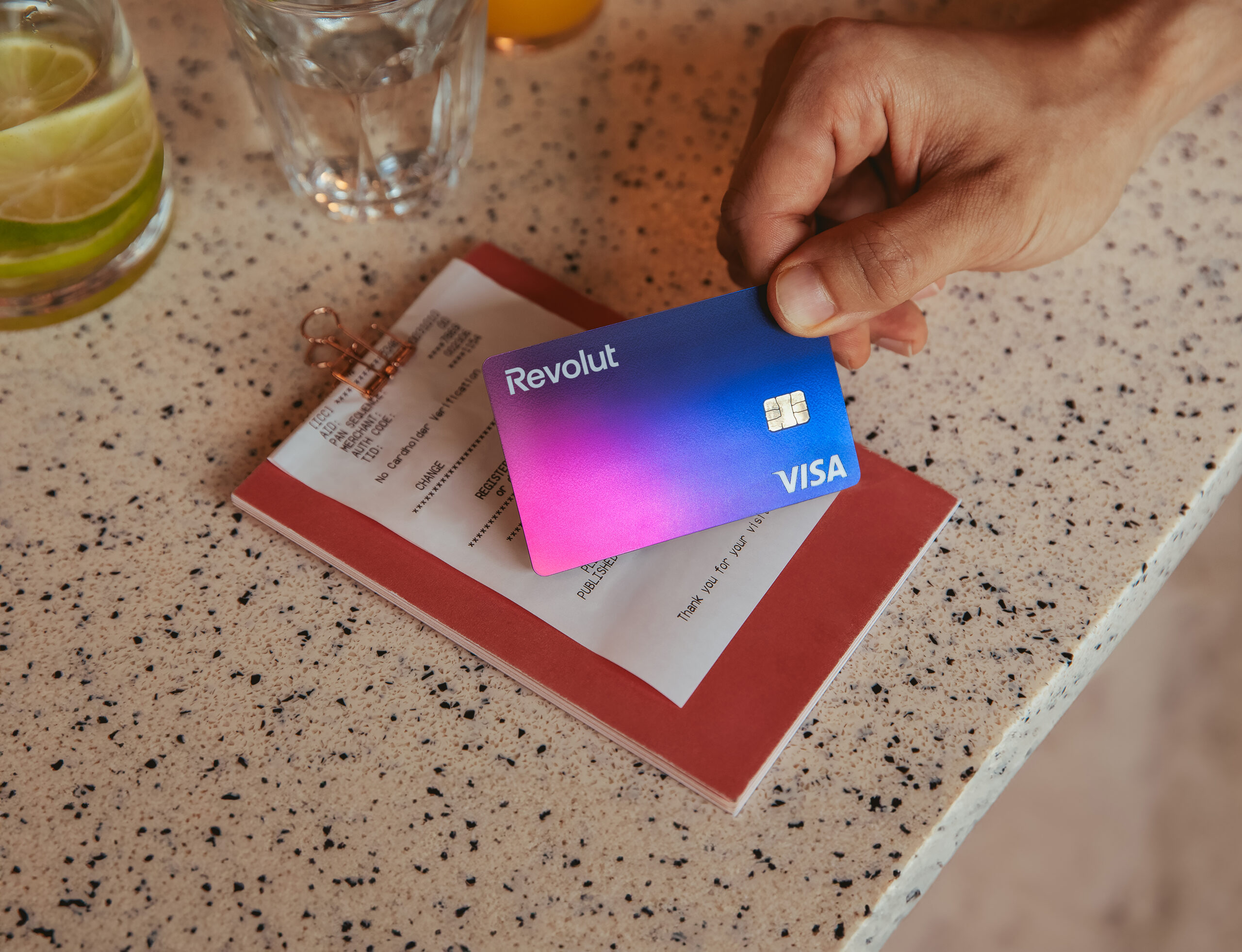
Read our Revolut Card Review
Revolut Travel Card
- No fee ATM withdrawals up to A$350, or 5 ATM withdrawals, whichever comes first, per rolling 30 day period and 2% of withdrawal amount (minimum charge of A$1.50) after that
- Exchanging currency on the weekend can incur a 1% mark-up fee
- Fees on international money transfers were introduced in April 2021.
- Can be used wherever Visa is accepted
The Revolut Travel Card is a decent option for those who travel a lot as it offers over 30 currencies at a great exchange rate, which is the cheapest rate globally. However if you exchange currency on the weekend you can incur a one-percent mark-up fee. In addition they have introduced fees for international transfers. Finally if you use ATMs frequently this is not the card to use due to the fees.
Travelex Money Card - Best All Rounder
Best features.
- Unlimited free ATM withdrawals
- 24/7 Emergency Assistance
- Initial and replacement card are free
- Lock in up to 10 currencies
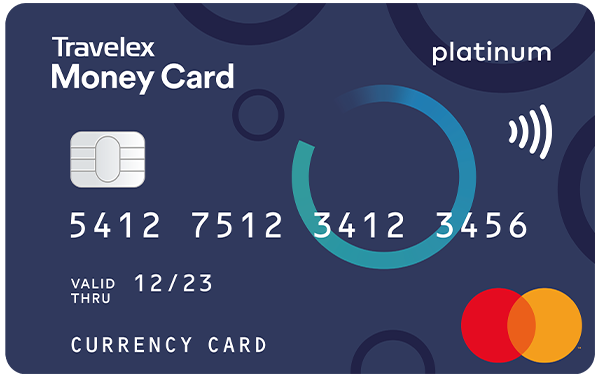
Read our Travelex Travel Card Review
Travelex Money Card
- Minimum load of $100 and maximum load of $100,000
- Can be used wherever Mastercard is accepted
- Fees include a $10 closure fee, $5 for an additional card and $4 inactivity monthly fee.
- While Travelex don't charge ATM fees, some ATM operators may charge their own fees.
- Currencies that can be loaded are AU$, US$, EU€, GB£, NZ$, TH฿, CA$, HK$, JP¥, SG$
- If your card is lost or stolen you can access cash in your account through Moneygram or Western Union agents, with no charge
- Boingo hotspots offer free wifi and you can look at their number of free hotspots per country on this map
The Travelex Card is a good all rounder.
You can use it to take money out of the ATM, for merchant purchases like restaurants and even for online shopping in foreign currency. While the exchange rates aren't as good as the Wise or Revolut Card abroad , the support network if the card is lost or stolen is very good.
Bankwest Breeze Platinum Credit Card - Lowest Interest Rate
- Lowest interest rate at 9.90%
- No international transaction fees on purchases
- 0% p.a. on purchases and balance transfers for the first 15 months
- Up to 55 days interest free on purchases
- Low annual fee
- Complimentary international travel insurance
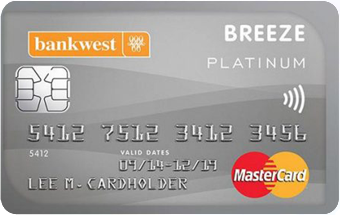
Bankwest Breeze Platinum Credit Card
- Free annual fee first year, then $69 annual fee
- 55 interest free days
- Free international travel insurance that includes the basics but does not cover cancellation costs, pre existing conditions and travellers over 80
- $6,000 minimum credit card
- 0% p.a. on purchases and balance transfers for the first 15 months, then reverts to 9.90%
- 21.99% interest rate on purchases and cash advances
- Cash advance fee of the higher of $4 or 2% of cash advance
The Bankwest Breeze Platinum is a great no frills credit card that offers ‘no foreign transaction fees’ and the lowest interest rate on the market, at 9.90%. These two factors alone will save you hundreds of dollars when travelling overseas.
In addition it has a low annual fee and complimentary international travel insurance. Finally for its price point it is a great value credit card that will be accepted most places around the world.
HSBC Everyday Global Debit Card
- No initial card or closure fees
- No monthly or account fees
- No international ATM fees
- No cross currency conversion fees
- Lock in very competitive exchange rates before travel
- No maximum balance
- Earn 2% cashback
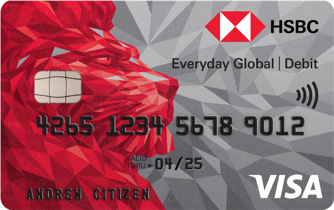
- 10 Currencies can be loaded are AUD, USD, GBP, EUR, HKD, CAD, JPY, NZD, SGD, CNY (currency restrictions apply to CNY)
- Awarded 5 gold stars by CANSTAR in 2021 for Outstanding Value
- Very competitive exchange rates on all currencies when you have currencies already loaded on your card
- ATMs within Australia need to be HSBC and overseas they need to display a VISA or VISA Plus logo, not be be charged fees
- Earn 2% cash back when you tap and pay with Visa pay wave, Apple Pay or Google Pay for purchases under $100. With a maximum of $50 cash back per month. In addition you need to deposit $2,000 or more into your Everyday Global Account each calendar month.
- Daily maximum ATM withdrawal is $2,000
- Fraud protection covered by Visa Zero Liability
The HSBC Everyday Global Debit Card is a good option to take travelling and to spend money in Australia with no international transaction fees, international ATM fees and monthly fees. In addition there is no maximum balance on currencies held and a 2% cash back incentive when you tap and pay under $100.
Finally it is one of the only travel cards that offers Chinese Yuan. To avoid ATM fees you need to find HSBC branches in Australia and only use ATMs overseas with a VISA or VISA Plus logo.
Best Student Card
Pelikin student traveller card.
- Use promo code SMONEY10 for a $10 discount
- Up to 15% off international flights
- A globally accepted virtual student ID card
- 2% cash back on food & drinks, transport and accommodation
- Over 150,000 discounts worldwide

- $30 for 12 months
- 20+ currencies available
- Split bills, pay and get paid instantly
Pelikin is one of the only travel cards in Australia specifically for students. While it has a small annual fee, the range of discounts and offers more than make up for it.
The app is relatively easy to use and card arrives in under a week.
Best Rewards Card
Qantas travel money card.
- No monthly fees, purchase fees and currency conversion fees
- No load fees if you pay by bank transfer or BPay
- Locked in exchange rates: 4%+ margin on exchange rates
- Earn 1.5 Qantas points for every AU$1 spent in foreign currency
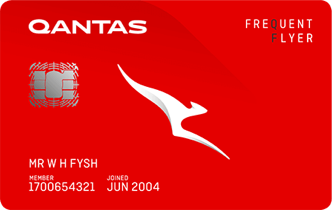
- 10 currencies offered USD, GBP, EUR, THB, NZD, SGD, HKD, CAD, JPY, AED
- Free Australia ATM withdrawals
- 0.5% fee debit card reload fee
- ATM fees overseas (USD 1.95; GBP 1.25; EUR 1.50; THB 70; NZD 2.50; SGD 2.50; HKD 15.00; CAD 2.00; JPY 160; AED 6.50)
- Minload of $50 and max of $20,000
- Available to 16 year olds, has a lower age restriction than most credit cards (18 year olds)
Qantas Travel card is a great option to spend foreign currency overseas if you are already a loyal Qantas customer and use your frequent flyer points regularly on flights, accommodation or gifts. The fees are low, the exchange rate is average however the ATM fees are expensive and will easily add up.
Other popular travel money cards
Aside of the Top 5 travel money cards, there are many more options to consider. These include well known brands such as the Commonwealth Bank and Travelex and less known services like Up Bank and Revolut.
Here is a rundown of their best features, fees and available currencies:
- 13 currencies available, including Vietnamese Dong and Chinese Yuan
- No issue fee, load fees, closure and card replacement fees
- Additional card offered
- Can be accessed through Commonwealth Bank app
Commonwealth Bank Travel Money Card
- $3.50 fee at ATMs overseas
- 13 currencies offered USD, GBP, EUR, THB , NZD, SGD, HKD, CAD, JPY, AED, AUD, VND & CNY
- Minload of $1 and max of $100,000
- Available to 14 year olds, has a lower age restriction than most credit cards (18 year olds)
- When you use your card for a purchase or withdrawal in a currency that is not loaded, or when they automatically transfer funds between the currencies on your card to enable the completion of the transaction at the Visa retail exchange rate plus 4%
- To transfer money between currencies or a transaction account, it will be at the bank rate which is normally 4% above the market value
The Commonwealth Bank travel money card is great if you are already a Commonwealth bank customer who banks online and knows exactly how much money in each country you want to spend. However if you need to transfer between currencies or make a purchase in a currency you don't have funds loaded, then you can get an additional expensive charge. Watch how many withdrawals at ATMs you make as well to keep the costs down.
- Exchange rates most competitive for USD, GBP and THB
- No fee on initial card or load (not BPay)
- No fee on reloads via bank transfers
- No monthly or inactivity fees
- Card is valid for 5 years
Travel Money Oz Currency Pass
- 1.1% reloading fee via Travel Money Oz Login or with debit or credit card
- 1% reloading fee for BPay
- $10 closure fee and replacement card fee
- 2.95% on withdrawals from Australian ATMs is expensive
- Roughly $3.50 on withdrawals from overseas ATMs is expensive.
- $3.99 + 5.95% fee on cross currency transactions
- 10 Currencies can be loaded are USD, EUR, GBP, NZD, CAD, HKD, JPY, SGD, THB & AUD
- Exchange rates for SGD and CAD are the least competitive
- Minload of $20 and max of $10,000
- Only 1 card per account
- According to the website they won't take online orders if you are departing within 14 days as the card can take up to 2 weeks for delivery.
The Travel Money Oz travel money card seems to be an outdated version of the Travelex or Australia Post travel card as it does not offer Global Emergency Assistance or Boingo hotspots. However exchange rates and fees are similar to Travelex, so if you are travelling to the US, UK or Thailand, this is a great card to pay for accommodation and things in shops. We would avoid using it at any ATM, to save costs.
- No ATM fees in Australia or internationally
- No minimum monthly deposit
- No account keeping fees
- Can be used in Australia as an EFTPOS card
- Available to 14 year olds and older
Macquarie Travel Card
- $2,000 daily limit for ATM withdrawals
- Simple and easy to work out costs for account
- Exchange rates are MasterCard exchange rates, which are normally 4%+ market rate.
- 90-day theft and damage protection on eligible purchases and stolen wallet protection up to $500
- Can be used in Australia to buy goods overseas and not pay international transaction fees
- Get discounts of up to 10% on eGift cards to use at over 50 leading retailers
The Macquarie Travel Card is a very good option to take overseas for ATM withdrawals as they are all free. In addition in Australia you can buy goods online and not pay an international transaction fee. Furthermore you can use the card like a normal debit card in Australia with no hefty fees or monthly minimum deposits. However the exchange rate is the MasterCard rate which is normally 4%+ above the market rate. Finally we would recommend this card for cash withdrawals at ATMs internationally but not paying for accommodation due to the added margin on the MasterCard exchange rate.
- Cheapest way to send money overseas through a bank
- UI and UX better than traditional banks making it super easy to use
- Competitive savings interest rate
Up Bank Travel Card
- Backed by Bendigo Bank and Adelaide Bank and partnered with Wise so it has financial backing and access to the cheapest exchange rates to send money overseas
- Nifty online tools to help you track spending, budget and save. These include a detailed transaction history often including a company logo, when you paid down to the minute and the suburb where the transaction was made. In addition it has a ‘Regulars feature that detects regular billers and estimate of upcoming bills so you get a heads-up before they are due
- Good savings account interest rates of 1.85% (0.10% base rate plus 1.75% bonus). Bonus interest is easily unlocked after making five successful card or digital wallet purchases each month
The Up Bank Travel Card is aimed at younger markets who are looking to save on bank costs and receive online tools to help them budget and save for their goals. It is also able to be used overseas at any ATM without fees, no international fees and is the cheapest way to send money overseas through a bank due to their partnership with Wise (the largest money transfer company in the world). In addition the exchange rates are Mastercard rates which are normally 4% above interest rates. Finally, while this card is very useful domestically and for ATMs overseas we would not recommend it for big ticket items overseas as it is an expensive card to use.
- No foreign transaction fees
- No fee on initial card, load, unload or inactivity fees
- No cross currency transactions fees
- Lock in exchange rates before you leave
- Exchange rates most competitive for USD, GBP, EUR and CAD and JPY
- No ATM fee at 50,000 Global Alliance ATMs worldwide
- Free additional card
- Flight delay pass
Westpac Travel Money Card
- 11 Currencies can be loaded are USD, EUR, GBP, NZD, CAD, HKD, JPY, SGD, THB, AUD & ZAR
- $2,000 maximum limit on ATM withdrawals overseas within 24 hours
- $50,000 maximum limit on currencies loaded on to travel card
- $3 roughly for ATMs that are not within the Non Westpac Global Alliance
- If you run out of one currency on the card, you can pay with other currencies without the expensive cross currency transaction fee
- No foreign transaction fees, initial card, load, unload or inactivity fees
- According to the Westpac it can take upto 8 business days to receive the travel card
- Secure from fraudulent transactions with Mastercard Zero Liability protection
- 2 cards per account for free
The Westpac Travel Card is a no frills handy travel card with very low fees, no foreign transaction fees, access to some free ATMs worldwide and competitive exchange rates, especially on USD, EUR, GBP, CAD and JPY. In addition it has the South African Rand (ZAR) which is not common in prepaid travel cards. Finally it has access to a flight delay pass in case your flights are delayed and you need to access airport lounges.
- Linked to ANZ Rewards program
- 7 types of insurance for free
- 55 days interest free
- Good security on card purchases
ANZ Travel Adventure Card
- 20.24% interest on purchases and cash advances
- $120 annual fee
- No international transaction fees in person or online
- Offer 7 types of insurance for free
- ANZ Reward points can be used to buy gift cards, swap for Virgin or Singapore airline points or cash into your account.
- Earn 1.5 Reward points per $1 spent on eligible purchases up to $2,000 per statement period
- ATM fees at non ANZ ATMs
- Minimum credit of $6,000
If you utilize rewards points then the ANZ Travel Adventure Card might be suitable for you. Reward points can be used to buy a wide range of gift cards, swap for Virgin or Singapore airline points or cash into your account. In addition no international transaction fees are charged for purchases online or whilst you travel overseas. Finally this card is not recommended for cash withdrawals as the interest rate of 20.24% will eat up any savings.
- No ATM fees
- Can be used in Australia with no additional costs
- No fees for paying via bank transfer or Bpay
- Transfer limits can be set by user
ING Orange Everyday Account Debit Card
- As long as you you deposit at least $1000 and make at least 5 payments each month ING will waive international transaction fees and refund overseas ATM withdrawal fees
- Can be used in all countries
- Works with Apple Pay and Google Pay
- Visa currency conversion rates apply, which are normally 4% above market
The ING Orange Everyday Account Debit Card is a good card for most Australians travelling overseas for ATM access, with no fees. It also allows you to to buy goods online without an international transaction fee.
Furthermore you can use it in Australia for free and there are no fees to get your initial card, for account keeping or to top up your card. A word of caution however, if you travel overseas for longer than 1 month, you still need to deposit at least $1,000 and make at least 5 payments each month to get the rebates.
- Initial card and replacement cards are free
- Increased protection with Mastercard Zero Liability
- Access to cash from your account through the Global Emergency Assistance, if your card is lost or stolen

Australia Post Travel Money Card - Platinum Mastercard
- 1.1% Admin fee for instore loads, including initial load
- $5 fee for reloads via debit bank card
- $10 closure fee
- $3.50 on withdrawals from overseas ATM is expensive
- Currencies that can be loaded are USD, EUR, GBP, NZD, THB, CAD, HKD, JPY, SGD , AED and AUD
- Minload of $100 and max of $100,000
- If your card is lost or stolen you can access cash that is in your account through Moneygram or Western Union agents, with no charge
- Boingo hotspots offer the free wifi and you can look at their number of free hotspots per country on this map
The Australia Post travel money card is a popular option for Australian travellers due to the convenience of stores. However we would recommend the Australia Post travel money card for paying in shops or accommodation as it is costly to withdraw cash from ATMS. As the Australia Post travel money card is fee heavy we recommend not making withdrawals at ATMs or making cross currency transactions to keep additional fees down.
- Up to 11 currencies available
- Manage your account and card online
- 24/7 global assistance
- Access to emergency cash
- Free additional card when ordered at time of purchase
- Can be used at millions of locations worldwide – wherever Mastercard purchase symbol is displayed
Greater Bank Cash Passport Platinum Mastercard
- $5 fee for reloads via debit bank card, FREE reloads via BPAY
- Admin fee of up to the greater of 1.1% of the load/reload amount or $15 for in-store purchases
- Debit card load fee 0.5% of the amount loaded, per Debit Card Load transaction
- Domestic ATM fee 2.95% of value Withdrawn
- International ATM fee USD 2.50, EUR2.50, GBP 2.00,NZD 3.50, THB80.00, CAD 3.50,HKD 18.00, JPY260.00, SGD3.50, AED 10.00, AUD 3.50
- Minimum load of AUD100 and a Maximum of AUD100,000
The Cash Passport is one of the most popular travel cards in the Australian market. With Greater Bank, you can purchase it online and at one of their branches, then download the app or use the website to manage your card. While the card may be useful for international purchases, be mindful when using an ATM both locally or overseas as the fees can add up if you are withdrawing money often.
Learn more about the Cash Passport Platinum Mastercard through Greater Bank .
The best travel card in Australia depends on its use, for ATM withdrawals it is ING Orange , for best exchange rates it is Wise Travel Card, the best credit card is Bankwest Breeze Platinum , for overall best card by a bank its HSBC Global and the best rewards card is the Qantas Travel card .
A travel money card is safer than cash overseas and if you select a Wise travel card , it is the best exchange rate as well. Most places around the world accept MasterCard or Visa, so you should be able to pay for all your purchases by card.
Yes you can use all travel cards in Australia but you might choose not to due to the fees. ING , Macquarie , Up , Citibank are all good examples of travel money cards that do not charge for ATM withdrawals in Australia. However examples of travel money cards that charge $3.50 per Australian ATM withdrawal include Travelex , Australia Post and Travel Money Oz .
Both if you buy your cash from S Money and pay with a Wise card overseas, as they both use the exchange rate you see online and charge very low fees. However if you buy your foriegn currency at the airport, you are paying top prices so using a card is cheaper.
There are many travel money cards that no longer exist but appear in search engine page results. Travel money cards that no longer exist include 7-11 Just Go, NAB Travel Money Card, Travelex Cash Passport, Australia Post Cash Passport, ANZ Travel Card, Westpac Global Currency Card and the Virgin Velocity Global Wallet program.
Learn more about the best debit, credit and prepaid cards for travel

Best Prepaid Cards

Credit Card

More Travel Card Guides
Learn more about the best travel money cards for your holiday destination.
ASIC regulated
Like all reputable money exchanges, we are registered with AUSTRAC and regulated by the Australian Securities and Investment Commission (ASIC).
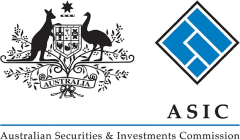
S Money complies with the relevant laws pertaining to privacy, anti-money laundering and counter-terrorism finance. This means you are required to provide I.D. when you place an order. It also means the order must be paid for by the same person ordering the currency and you must show your identification again when receiving your order.

Best Travel Cards in Australia in 2023 For Overseas Travel

Byron Mühlberg
Monito's Managing Editor, Byron has spent several years writing extensively about financial- and migration-related topics.
Jarrod Suda

A writer and editor at Monito, Jarrod is passionate about helping people apply today’s powerful finance technologies to their lives. He brings his background in international affairs and his experiences living in Japan to provide readers with comprehensive information that also acknowledges the local context.
Links on this page, including products and brands featured on ‘Sponsored’ content, may earn us an affiliate commission. This does not affect the opinions and recommendations of our editors.
From the multitude of bank fees and ATM charges to hidden currency conversion fees, there's no question that travelling abroad can be a costly endeavour — and that's saying nothing of the cost of the holiday itself!
As you prepare for your trip abroad, the golden rule is to pay using the local currency of your destination. This means accessing local cash with ATMs and using a prepaid debit card that can access the local currency. If it's not possible for you to spend in the local currency when travelling abroad, then spending in your home currency while using a card that doesn't charge any hidden exchange rate markups from your bank (e.g. only paying Visa or Mastercard exchange rates to convert currency) is still a good bet for most Australians when travelling abroad.
In this guide, we explore cards like Revolut and Wise that can lower ATM fees and hold multiple currencies. Spend on your holiday like a local and enjoy peace of mind after each tap and swipe.
In general, we consider Revolut to be the best travel card in Australia for all-around use, as its versatile account and card can be used to spend like a local pretty much anywhere in the world. With Revolut, you'll get a debit card, multi-currency account balance in 32 currencies, and a savvy mobile experience.
Best Travel Cards in Australia
- 01. Revolut — Best all-round travel card in Australia scroll down
- 02. Wise — Best for number of currencies and foreign account details scroll down
- 03. Considering going through your bank scroll down
- 04. Compare the best travel cards in Australia scroll down
- 05. Tips to save money when travelling overseas scroll down
- 06. FAQ about the best travel cards in Australia scroll down
Revolut: Best All-Round Travel Card in Australia
Revolut is impressive for its vast currency options and additional services, such as international money transfers and a money management interface. Revolut is one of the most well-known mobile finance platforms in the world because it offers services not only in Australia but also across Europe, the Americas, and Asia.
Like Wise, Revolut converts your currency to the local currency of your travel destination at the Revolut rate, which is close to the real mid-market exchange rate. It does set a cap on free allowances, however, since fair use limits and weekend surcharges may apply (Revolut's Standard Plan only allows free exchanges for transfers worth $1,000 per month). Once you make your exchange from AUD to the local currency of your destination, your card will be treated like a local card (avoiding foreign transaction fees or dynamic currency conversions ).
ATM withdrawals are also free for the first $350. These allowances can be waived by upgrading memberships. Bear in mind that third-party ATM fees may apply, even though Revolut doesn't charge any fees of its own for withdrawals up to $350 per month.

- Trust & Credibility 8.9
- Service & Quality 7.9
- Fees & Exchange Rates 8.3
- Customer Satisfaction 9.4
- Account name: Standard
- Account type: Personal account (not a bank)
- Total cost: $0 per month .
- Noteworthy features: AUD account details, multi-currency balances.
- More info: See our full Revolut review .
Wise: Best for Number of Currencies and Foreign Bank Details
Wise has one of the best multi-currency cards available on the market. Load up to 54 currencies onto this card at the real exchange rate, giving you access to truly global travel.
Unlike banks, credit unions, airport kiosks, and foreign ATMs, Wise is transparent about never charging a hidden exchange rate margin when you convert your home currency into up to 54 currencies. The live rate you see on Google or XE.com is the one you get with Wise. An industry-low commission fee per transaction will range from 0.35% to 2.85%, depending on the currency.

- Trust & Credibility 9.3
- Service & Quality 8.9
- Fees & Exchange Rates 7.6
- Customer Satisfaction 9.6
- Account name: Multi-Currency Account
- Account type: Electronic Money Account (held by local banks).
- Total cost: $0 per month.
- Noteworthy features: International money transfers, multiple account details, multi-currency balances.
- More info: See our full Wise Account review .
Consider Your Australian Bank Travel Money Card
Another option for spending abroad is to use your bank. Some Australian banks offer prepaid debit cards onto which you can load AUD and convert it into many countries around the world. These include the Commbank Travel Money Card. However, as of 2023, some banks such as ANZ, NAB, and Westpac have cancelled their travel card offerings, meaning you'll need to use a third-party prepaid card like Revolut .
You could also travel abroad with your ordinary debit or credit card, however, this will generally be the most expensive choice , as in most cases you'll pay an exchange rate fee plus a currency conversion fee. If you decide to use a standard bank card, make sure that you choose a card produce that explicitly waives foreign transasction fees .
What’s the Best Travel Card in Australia?
To discover the best travel money card in Australia to suit your overseas travel needs, compare the two fintech offerings we discussed above, Wise and Revolut, with a typical bank travel card like CBA's Travel Money Card:
Last updated: 6/1/2023 ¹ Bank account details in USD, EUR, GBP, AUD, NZD, SGD, CAD, RON, HUN, and TRY
Money-Saving Tips When Traveling Abroad From Australia
When you convert Aussie dollars into a foreign currency, foreign exchange service providers will charge you two kinds of fees:
- Exchange rate margin: Providers apply an exchange rate that is poorer than the true "mid-market" exchange rate . They keep the difference, called an exchange rate margin .
- Conversion fee: This fee is usually a percentage of the amount converted or a fixed amount, which is charged for the service provided.
With these facts in mind, let's see what practices are useful to avoid ATM fees, foreign transaction fees, and other charges you may encounter while on your travels.
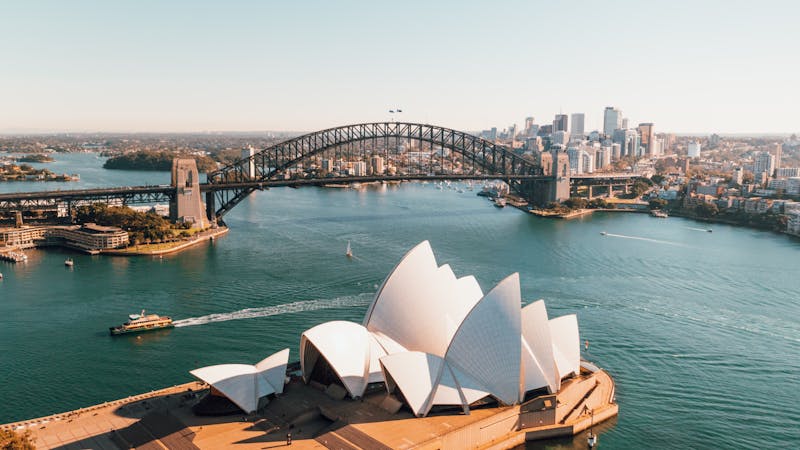
Tip 1: Avoid Bureaux de Change
Have you ever wondered how bureaux de change and currency exchange desks are able to secure prime real estate in touristic locations like the Champs-Élysées in Paris or Covent Carden in London while claiming to take no commission? It’s easy: they make (plenty of) money through hidden fees on the exchange rates they’re giving you.
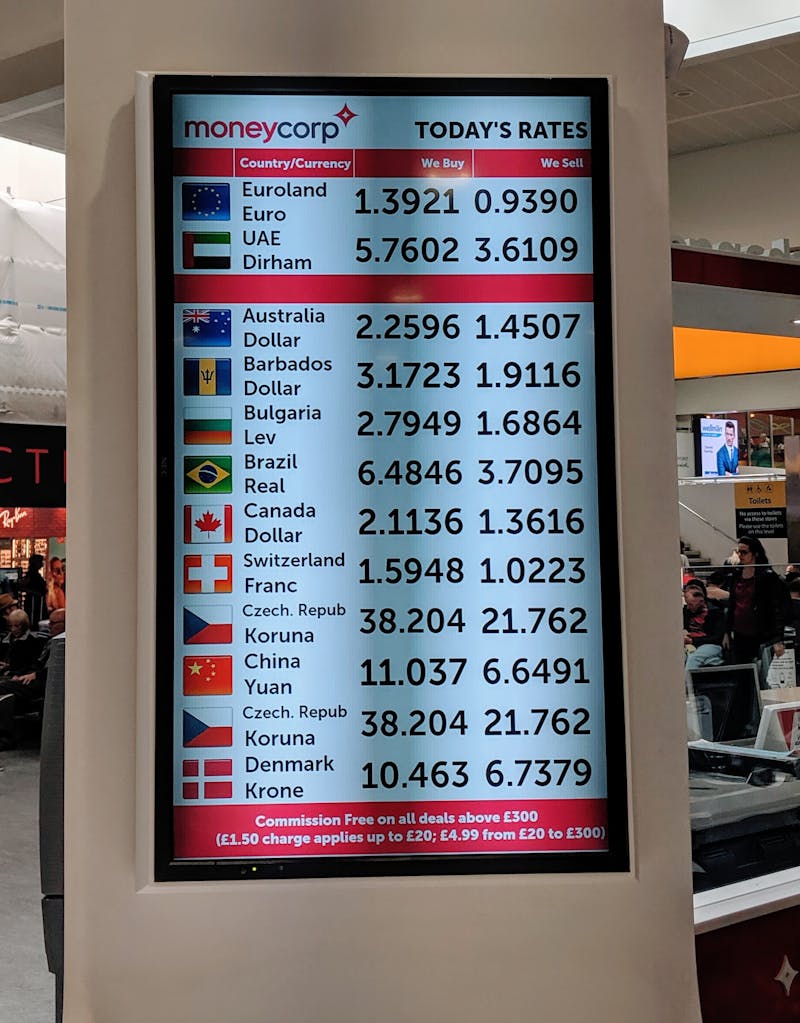
Our study shows that Bureaux de Change in Paris charges a margin ranging from 2.15% at CEN Change Dollar Boulevard de Strasbourg to 16.6% (!!) at Travelex Champs-Élysées when exchanging 500 US dollars into Euros for example.
If you really want cash and can’t wait to withdraw it with a card at an ATM at your destination, ordering currencies online before your trip is usually cheaper than exchanging currencies at a bureau de change, but it’s still a very expensive way to get foreign currency which we, therefore, would not recommend.
Tip 2: Always Pay In the Local Currency
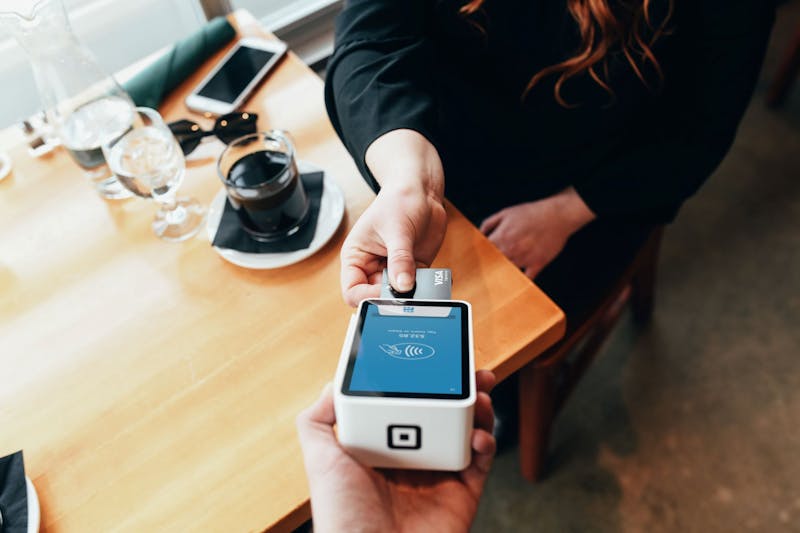
Don’t fall for the dynamic currency conversion trap! When using your card abroad to pay at a terminal or withdraw cash at an ATM, you’ve probably been asked whether you’d prefer to pay in your home currency (i.e. Australian dollars) instead of the local currency of the foreign country. This little trick is called dynamic currency conversion , and the right answer to this sneaky question will help you save big on currency exchange fees.
As a general rule, you always want to pay in the local currency (Euros in Europe, GBP in the UK, DKK in Denmark, THB in Thailand, etc.) when using your card abroad, instead of accepting the currency exchange and paying in Australian dollars.
This seems like a trick question - why not opt to pay in AUD? On the plus side, you would know exactly what amount you would be paying in Aussie dollars instead of accepting the unknown exchange rate determined by your card issuer a few days later.
What is a Dynamic Currency Conversion?
When choosing to pay in AUD instead of the local one, you will carry out what’s called a “ dynamic currency conversion ”. This is just a complicated way of saying that you’re exchanging between the foreign currency and AUD at the exact time you use your card to pay or withdraw cash in a foreign currency, and not a few days later.
For this privilege, the local payment terminal or ATM will apply an exchange rate that is often significantly worse than even a traditional bank’s exchange rate (we’ve seen margins of up to 8%!), and of course, much worse than the exchange rate you would get by using an innovative multi-currency card.
Knowing what amount you will pay in Australian dollars is not worth the additional steep cost of the dynamic currency conversion, hence why we recommend always choosing to pay in the local currency.
Tip 3: Don't Use a Traditional Card To Pay
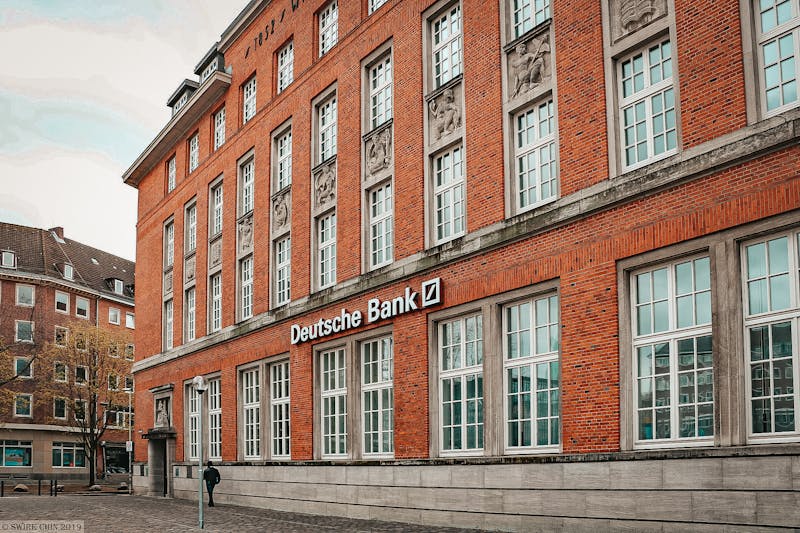
Only use traditional Australian bank cards for overseas travel if they waive international card transaction fees . As mentioned before, providers make money on foreign currency conversions by charging poor exchange rates — and pocketing the difference between that and the true mid-market rate. They also make money by charging commission fees, which can either come as flat fees or as a percentage of the transaction.
FAQ About the Best Travel Cards in Australia
Having reviewed and compared several of the industry's leading neobanks, experts at Monito have found Revolut to offer the best prepaid multi-currency card in 2023 in Australia.
In general, yes! You can get a much better deal with new innovative travel cards than traditional banks' debit/credit cards. However, not all cards are made equal, so make sure to compare the fees to withdraw cash abroad, the exchange rates and monthly fees to make sure you're getting the best deal possible.
- Sign up for a multi-currency account;
- Link your bank to the account and add Aussie dollars;
- Convert amount to the local currency of holiday destination ( Wise and Revolut convert at or near the actual mid-market rate);
- Tap and swipe like a local when you pay at vendors.
Yes, the Wise Multi-Currency Card is uniquely worthwhile because it actually converts AUD into foreign currency at the real mid-market exchange rate . Wise charges a transparent and industry-low commission fee for the service instead. More traditional currency cards like the Travelex Money Card are good alternatives, but they will apply an exchange rate that is weaker than the mid-market rate.
The Wise Multi-Currency Card is the best money card for euros because unlike banks, credit unions, airport kiosks, and foreign ATMs, Wise is transparent about never charging a hidden exchange rate margin when you convert your local currency into euros with them.
The live rate you see on Google or XE.com is the one you get with Wise . An industry-low commission fee will range from 0.35% to 2.85%. USD to EUR transfers generally incur a 1.6% fee.
Learn more about how to buy Euros in the United States before your trip.
There are usually three types of travel cards, prepaid travel cards, debit travel cards and credit travel cards. Each have pros and cons, here's a short summary:
- Prepaid travel cards: You usually need to load cards with your home currency via a direct entry or credit/debit card top-up. You're then able to manage the balance from an attached mobile app and can use it to pay in foreign currencies or withdraw cash at an ATM abroad tapping into your home currency prepaid balance. With prepaid travel cards, as the name indicates, you can't spend more than what you've loaded before hand. Some prepaid card providers will provide ways to "auto top-up" when your balance reaches a certain level that you can customize. On Revolut for example, you can decide to top-up £100/£200/£500 from your debit card each time your balance reaches below £50.
- Debit travel cards: Some innovative digital banks, like N26 or Monzo, offer travel debit cards that have the same advantages than a Prepaid Travel Cards, except that they're debit card directly tapping into your current account balance. Like a Prepaid travel card, you can't spend more than the balance you have in your current account with N26 or Monzo, but you can activate an overdraft (between €1,000 or €10,000 for N26 or £1,000 for Monzo) if you need it, for a fee though.
Note that even if they're Prepaid or Debit cards, you can use them for Internet payments like a normal credit card.
- Credit travel cards: You can find credit cards made for international payments offering good exchange rates and low fees to withdraw money abroad, but you'll need to pay interests in your international payment if you don't pay in FULL at the end of every month and interest on your ATM withdrawals each day until you pay them back.
Other Monito Guides and Reviews on the Best Travel Cards in Australia and Top Multi Currency Cards
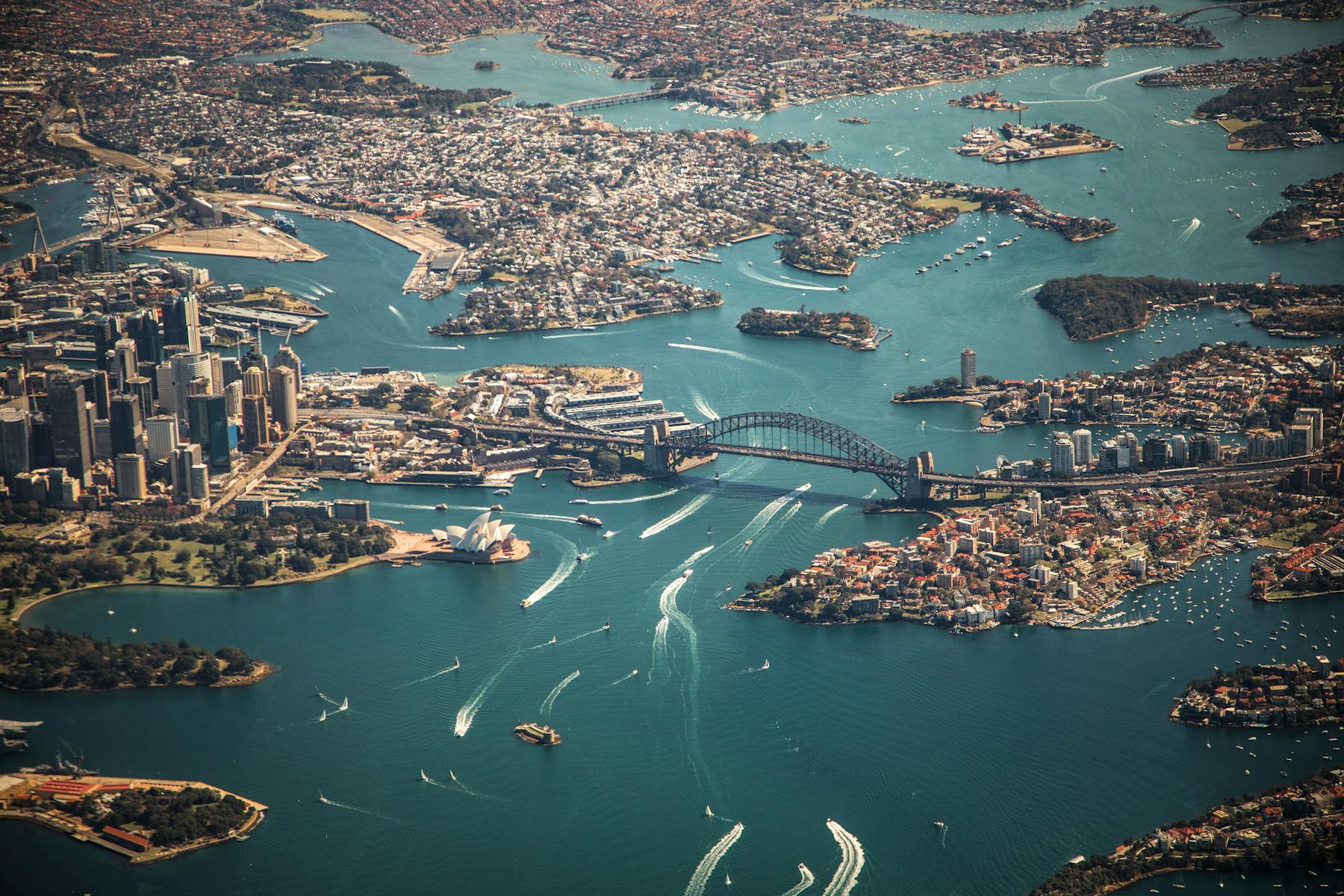
Why Trust Monito?
You’re probably all too familiar with the often outrageous cost of sending money abroad. After facing this frustration themselves back in 2013, co-founders François, Laurent, and Pascal launched a real-time comparison engine to compare the best money transfer services across the globe. Today, Monito’s award-winning comparisons, reviews, and guides are trusted by around 8 million people each year and our recommendations are backed by millions of pricing data points and dozens of expert tests — all allowing you to make the savviest decisions with confidence.
Monito is trusted by 15+ million users across the globe.
Monito's experts spend hours researching and testing services so that you don't have to.
Our recommendations are always unbiased and independent.
- Argentina
- Australia
- Deutschland
- Magyarország
- New Zealand
- Österreich
- Singapore
- United Kingdom
- United States
- 繁體中文 (香港)
The 6 Best Travel Money Cards for Australia 2024

Heading to Australia to kick back on the world famous beaches, soak in the city atmosphere, or explore the open road? Or maybe you’re off for a working holiday, or as a longer term move to live, work, retire or study. In any case, picking up a travel debit, prepaid or credit card can help you manage your money across currencies, and cut the overall costs.
Different travel money cards have their own benefits and drawbacks. Join us as we look through your key travel money card options, and introduce a couple of our favourites from each category so you can see if any suit your preferences and needs.
Wise - our pick for travel debit card for Australia
Wise accounts can hold and exchange 40+ currencies, and you can get a linked Wise card for a one time delivery fee. Top up your account in GBP and switch to AUD before you travel. All currency conversion uses the mid-market exchange rate, with low fees from 0.41%. Here are some of the pros and cons of the Wise travel money debit card, to help you decide if it’s right for you.
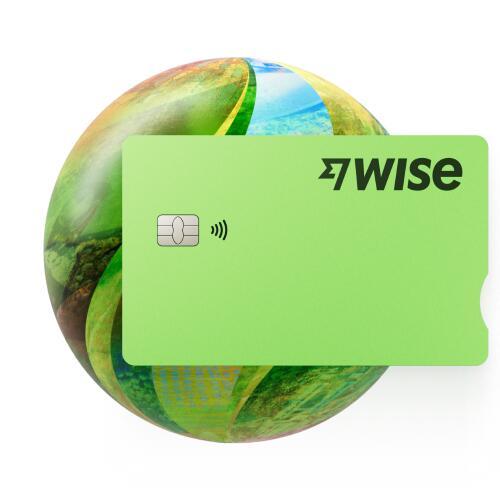
Hold and exchange 40+ currencies , including GBP-AUD
No fee to spend any currency you hold, low conversion fees from 0.41%
Mid market exchange rate on all currency conversion
Some fee free ATM withdrawals every month
No ongoing fees and no interest to pay
7 GBP delivery fee
No option to earn points or rewards
Click here to read a full Wise review
What is a travel money card?
A travel money card can help you cut costs whenever you spend in foreign currencies. Travel money cards can be debit or credit cards, but they all offer some international features and benefits such as options to hold a balance in multiple currencies, low or no foreign transaction fees, or cash back or rewards for spending and withdrawals overseas.
Once you’ve picked the travel money card that suits your needs you’ll be able to use it as easily as any other payment card, for in person and online shopping and cash withdrawals. Some cards also offer virtual card options for mobile payments.
What are different types of travel cards?
Travel cards can fall under the following categories. We’ll walk through the features and benefits of each in a moment, so you can see which might work best for your specific needs:
Travel debit cards
Travel prepaid cards
Travel credit cards
Quick summary: Best travel cards for Australia
The right travel card for you might depend on how long you’re spending in Australia and what you’ll be up to while you’re there. To help you weigh up some different options, we’ve included reviews of 2 of our favourite travel money cards from each category to help you choose. Here’s what we’ll be looking at:
Wise travel debit card : Hold 40+ currencies including AUD, with no ongoing fees, and spend with the mid-market exchange rate with no foreign transaction fee and low conversion costs from 0.43%
Revolut travel debit card : Hold 25+ currencies including AUD, in one of 4 different plan types, including some with no monthly fee, and some which comes with ongoing costs but which unlock more benefits and no fee transactions
Post Office travel money card : Hold AUD and 21 other currencies, with no fee to spend a currency you hold - 3% fee applies if you don’t have the currency required in your account
Monese travel money card : Hold a balance in GBP, then spend in AUD with no fees, up to your plan’s limit. Different plans on offer, including Simple which has no ongoing fees to pay
Barclays Rewards Visa travel credit card: Spend with the Visa exchange rate, and earn 0.25% cash back, with no foreign transaction fee and no cash advance fee. Interest and penalties can apply
Halifax Clarity Mastercard travel credit card: No foreign transaction fee, no annual fee, and no cash advance fee if you withdraw money at an ATM. Variable interest and penalties can apply
Travel money cards for Australia compared
Here’s a brief comparison of all the cards we’ve picked out - in a moment we’ll also look at each card in more detail.
When you’re figuring out which travel card suits you it’s worth thinking a bit about how you’ll use your card and account in Australia. If you’re there for work or need to send and receive AUD payments, a card with options to hold and receive Australian dollars - like the Wise card - can be handy.
If you’re looking for a card you can use on this trip and then in future for other holiday destinations make sure you pick one with no ongoing costs so you don’t run up a bill even when you’re not using your card. Finally, travel credit cards might suit you if you need to spread your costs over a few months - but bear in mind that fees and interest can apply in this case, pushing up the price in the end.
Travel Debit Cards for Australia
Travel debit cards can be ordered online from specialist providers, and will usually be linked to a digital multi-currency account. Different card accounts have their own features, but you can usually add money in GBP and then convert to AUD in the provider’s app, or just let the card manage the conversion for you at the point of payment. It’s worth knowing that some travel debit cards come with accounts with a broad suite of AUD functionality, including getting local bank details to get paid in AUD by local transfer. This can be a handy feature if you’re working in Australia, or visiting family and friends who may need to send you money in dollars.
Travel debit card option 1: Wise
There’s no fee to open a personal Wise account , but you’ll pay a one time card order fee of 7 GBP. After that there’s no minimum balance and no monthly charge. Wise accounts can support 40+ currencies for holding and exchange, with low fees from 0.43% when you convert currencies, and transparent ATM fees when you exhaust the monthly free transactions available with your account. Accounts come with local bank details for AUD so you can get paid easily.
No fee to open a personal Wise account, no minimum balance requirement
7 GBP one time fee to get your Wise card
2 withdrawals, to 200 GBP value per month for free, then 0.5 GBP + 1.75%
Hold 40+ currencies, convert between them with the mid-market rate
Get local account details to receive GBP, NZD, EUR, USD and a selection of other major currencies conveniently

Travel debit card option 2: Revolut
Revolut has a selection of different account tiers for personal customers in the UK, including Standard plans with no monthly fee, to the top end Ultra plan which has a 45 GBP/month fee and comes with loads of perks including a fancy platinum plated card. You can hold around 25 currencies, and convert currencies with the mid-market rate to your plan’s allowance. The higher account tiers also come with extras like various different forms of complimentary insurance, discounts, cash back opportunities and travel benefits.
No monthly fee for a Standard Revolut account, or upgrade to one of 4 different account plans which have monthly fees running from 3.99 GBP/month to 45 GBP/month
All accounts have some no fee weekday currency conversion with fair usage fees after that which are 1% for Standard plan holders
Standard plan holders can withdraw 200 GBP overseas per month for free
Hold around 25 currencies

Pros and cons of using debit travel cards in Australia
How much does a travel debit card cost.
Different travel debit card services set their own fees, which can include transaction fees, and monthly costs, depending on the card you pick. Generally, though, because travel debit cards are flexible and allow you to hold a foreign currency balance, you can avoid foreign transaction fees which keeps the overall costs of spending internationally down.
The good news is that you can select the provider and card that works best for you easily. Wise has a one time fee to get your card, but then no monthly charges or minimum balance requirements. Revolut customers in the UK can choose from different account plans, including one with no ongoing charges, or several different account options with a monthly fee in exchange for extra perks and benefits.
How to choose the best travel debit card for Australia?
There’s no single best travel debit card for Australia. Ultimately the decision will come down to personal preferences and spending habits, so you’ll need to compare a few to see which suits your spending and withdrawal needs best.
If you’re only in Australia for a short time and you’re unsure about travel debit cards you could always order a card with no ongoing costs like the Wise card or the Standard Revolut card, to try out whether or not a travel debit card suits you.
Is there a spending limit with a travel debit card in Australia?
You’ll probably find there’s a spending limit for your travel debit card. However, this limit can vary quite significantly, depending on the provider you pick. You can also usually adjust your spending limits for security in the provider’s app which means you can set the limit you’re comfortable with.
For the providers mentioned above, Revolut UK travel debit card holders have some spending caps based on merchant and transaction type. This applies to things like sending money to others, buying travellers cheques or money orders, and betting. Wise caps monthly card spending at 30,000 GBP but you can also move your limit lower if you’d like to, for security reasons.
ATM withdrawals
ATM withdrawals with a travel debit card are also likely to be subject to limits. Revolut applies a 3,000 GBP limit based on any given 24 hour period. Wise ATM withdrawal limits are 4,000 GBP per month. Both providers allow you to make some no fee ATM withdrawals monthly, but the exact amount you can withdraw will depend on your account type.
Prepaid Travel Cards for Australia
Prepaid travel cards are somewhat similar to travel debit cards but may not have quite the same functionality. You’ll usually still get your prepaid travel card from a non-bank provider like the Post Office or Monese and you can still usually manage your application and account remotely with just your phone if you want to. Prepaid cards can also offer multi-currency balance options, but one key difference is that the range of currencies covered may not be as broad as the range offered by travel debit cards. Let’s look at these options in more detail.
Prepaid travel card option 1: Post Office Travel Money Card
You can order a Post Office Travel Money Card online or pick one up in person at a branch as long as you have a valid ID on you. You’ll be able to top up and hold in 22 currencies, although bear in mind a fee applies if you add money in GBP. There’s no fee to add foreign currencies. The exchange rate used when you top up or convert may include a markup, but once you hold a currency balance in your account you can spend it with no further charges.
AUD and 21 other currencies are supported for holding and exchange
No fee to spend a currency you hold on your card
3% cross border fee if you spend in an unsupported currency
80 THB ATM withdrawal fee
Manage your account and card from the Post Office travel money app
Prepaid travel card option 2: Monese Travel Money Card
Monese offers several different account plans which come with linked cards you can use while overseas. Depending on the plan you pick you’ll get some free international spending and some free ATM withdrawals. Simple account plans have no monthly fees, but are more limited in terms of no-fee transactions compared to the other account tiers. While Monese does offer foreign currency account plans, these are not available in AUD.
- Pick the account plan that suits your needs, including a Simple plan with no monthly costs and some plans which do have a fee to pay every month
- Accounts offered in GBP, EUR and RON
- Simple account plan holders can spend up to 2,000 GBP a month in foreign currencies with no fees - other account plans have unlimited overseas spending with no extra fees
- All accounts have some fee free ATM withdrawals every month, with variable limits based on account plan
- Virtual cards available
Pros and cons of using prepaid travel cards in Australia
How much does a prepaid card cost.
Prepaid travel cards can have some fees, even if it’s free to get your card in the first place - which makes it essential to read the account terms and conditions carefully before you sign up. Among other things, look out for monthly maintenance fees, currency conversion charges, top up costs, and any account dormant fees that may apply. Weighing up a few different prepaid travel cards is the only way to decide which is the best value for your particular needs.
How to choose the best travel prepaid card for Australia?
The best prepaid travel card for Australia depends on your spending patterns. The Post Office Travel Money Card has the advantage that you can convert your money to AUD and see your budget instantly. However if you don’t do this, you might end up paying a 3% fee. Monese has different plan types, so has the flexibility to allow you to pick the one you want - but you can’t hold an AUD balance.
Prepaid travel card spending limit
The Post Office travel card lets you top up to 5,000 GBP at a time, with the maximum balance at any given time set at 10,000 GBP, or 30,000 GBP annually. Monese accounts may have different limits based on the tier you pick - usually set at a maximum holding balance at any time of 40,000 GBP. You may be limited to spending up to 7,000 GBP a day, depending on your account type.
With the Post Office card, you can make up to 17,000 THB maximum daily withdrawals and each withdrawal costs 80 THB. Monese accounts may have a maximum ATM withdrawal of 300 GBP a day, depending on the specific account you pick, so it’s worth reading the fee schedule carefully to understand the details.
Travel credit cards for Australia
If you’re going to be spending with a credit card in Australia anyway it could be worthwhile applying for a specific travel credit card before you go. These cards have been optimised for travel and can offer perks like no foreign transaction fee or more rewards and cash back for overseas spending.
If you pick a card with no annual fee, that can mean that using a travel credit card instead of your regular credit card when you’re away costs you less as you’ll dodge foreign transaction fees while still benefiting from network exchange rates. Bear in mind though that while credit cards can be safe and convenient, interest and penalty costs mean that they’re often more expensive than a debit or prepaid card.
Travel credit card option 1: Barclaycard Rewards Visa
The Barclaycard Rewards Visa credit card is a good, straightforward option for UK customers looking for a credit card which does not have foreign transaction fees, and which doesn’t have an annual fee. As with any credit card, some costs can apply including interest fees if you don’t clear your bill monthly, but you’ll be able to earn 0.25% cash back on all your card spending at home and abroad.
No annual fee, with 0.25% cash back on card spending
Currency exchange uses the network rate and no foreign transaction fee
No ATM withdrawal fee - but interest can still apply
28.9% representative APR, with penalty fees for late payments
Secure spending with extra protection on some purchases
Travel credit card option 2: Halifax Clarity Mastercard
The Halifax Clarity Mastercard has a variable interest rate which is based on your creditworthiness, but doesn’t use different rates for different transaction types as some cards do. There’s no foreign transaction fee when you spend or withdraw in foreign currencies, but bear in mind that an ATM operator might charge a fee, and interest accrues instantly for cash advance transactions.
No foreign transaction fee when spending or making a cash withdrawal overseas
Interest applies instantly when making cash withdrawals
Same interest rate applies on all purchase categories
Variable APR based on your credit score - you’ll need to check your eligibility online to see the APR you’d be offered
Spending is covered by the Consumer Credit act which means extra protections for purchases from 100 GBP to 30,000 GBP in value
Pros and cons of using credit cards for Australia
How much does a travel credit card cost.
As with any credit card, you may find that you run into fees when you use a travel credit card. While the travel credit cards highlighted above have no annual charge, and no foreign transaction fee, interest applies if you don’t pay your bill in full every month. If you’re late making a payment, penalties can also apply. Consider carefully if using a credit card is right for you to avoid running up unexpected or unmanageable bills.
How to choose the best travel credit card for Australia?
The best travel credit card for Australia depends on your preferences and situation. Because there’s an eligibility screening process with credit cards, you may find you can’t get approved for some cards if you don’t have an established and strong credit history. It’s generally worth looking for a card with no annual fee, and the lowest available interest rate, just in case you can’t always repay your bill monthly.
Travel credit card spending limit
Your travel credit card spending limit will be set by the card provider, and will depend on your credit score. You’ll be shown details of your spending limit when you’re approved for a travel credit card.
The cards we’ve looked at earlier don’t charge a cash advance fee, but this is a common cost when using a credit card at an ATM, so worth looking out for when you select any credit card. It’s also worth noting that it’s very common for ATM withdrawals to start accruing interest instantly, so you’ll end up needing to repay some charges whenever you use your credit card in an ATM.
How much money do I need in Australia?
There’s so much to do in Australia it’s pretty much impossible to suggest a one size fits all budget for your trip. How much you need to spend will depend entirely on what you’re planning on doing, how long you’ll stay and your personal preferences. The good news is that there are plenty of options out there so you should be able to find a budget and itinerary that suits you with a bit of research and planning. Here’s a quick look at some common costs in Australia:
Conclusion: Which travel money card is best for Australia?
You’re not going to end up short of fun things to do in Australia. But lots of activities means you’ll need to figure out the best way to pay for things while you’re there, to avoid unnecessary costs and make your money go further.
Using one or more travel card options can help you manage your travel budget flexibly, and may also mean lower overall costs. However, the right card and account for you will depend on your preferences and whether you need extras like ways to get paid in AUD by others.
Consider a Wise travel debit card if you need ways to pay and get paid in AUD, with the mid-market rate and low fees. Or as an alternative, check out a Monese travel prepaid card for free currency conversion to your specific plan limit, or a travel credit card like the Barclays Rewards Visa for cash back opportunities and ways to spread your costs over several months if you need to.
No matter what type of travel card suits you best, there’s going to be an option for you - use this guide to research and get ready to enjoy that trip of a lifetime to Australia.
FAQ - Best travel cards for Australia
Can you withdraw cash with a credit card in australia.
Yes. You can use your credit card to make an ATM withdrawal at any ATM in Australia where your card network is accepted. However, bear in mind you’ll pay interest instantly when you use a credit card in an ATM. Choosing to withdraw with a low cost travel debit card from Wise or Revolut may bring down your overall fees.
Can I use a debit card in Australia?
Yes. Debit cards are widely supported in Australia, and can be used in many places, although you may struggle at some small independent merchants or at markets. That said, having multiple ways to pay is reassuring, making carrying both a prepaid or travel debit card and some Australian dollars in cash a smart plan.
Are prepaid cards safe?
Yes. Prepaid cards are not linked to your normal UK bank account which means that they’re safe to use. Even if you were unlucky and someone stole your card while you’re in Australia, they would not be able to access your main account - and you could freeze your prepaid card in the app easily if you needed to.
What is the best way to pay in Australia?
Paying for things with a specialist travel debit, prepaid or credit card in Australia is most convenient. However, having a few options for payment is a good plan, just in case your preferred payment method can’t be used for some reason. Consider getting a travel card from a provider like Wise or Revolut, which has some no fee ATM withdrawals so you can also conveniently get cash as a back up, and for when card payments aren’t offered.
- Credit cards
- Personal Finance
What Is A Travel Money Card?
How does a travel money card work?
How many currencies can you load at once, other features to compare, how to get a travel money card, when is a travel money card worth it, alternative options.
A travel money card, also called a prepaid travel card, is a type of card that can hold foreign currencies. It’s intended for overseas travel, and you can use one to withdraw foreign cash from ATMs and to make purchases in a local currency.
Think of a travel money card as a debit card that uses local currency. Before you use a travel money card, you’ll preload a set amount of a specific international currency onto the card at the day’s exchange rate. For example, if you’re travelling to Italy and France for two weeks, you’d load Euros (€) onto the card and use it instead of your regular debit or credit card during your trip.
You can continue reloading money onto the card via an app or website as you spend your funds. So, if you blow through your Euros in Rome, you can top off your card’s balance before arriving in Paris.
Understanding the value of your exchange
The value you exchange currency for will depend on when you load your funds. Rates change from day to day, but you’ll lock in the rate used at the time you exchange currency. So, you’ll know the exact worth of the foreign currency in Australian dollars every time you use your preloaded card.
On the one hand, a locked-in rate protects you from volatile currencies with fluctuating values. However, if the rate drops, you could be stuck with devalued foreign funds. So, while you can’t predict the future, try to coordinate the load when the exchange rate is most valuable — even if that means waiting a few days.
The number of foreign currencies available will depend on the company providing the card, but you’ll generally find a wide variety of options. Even if dozens of currencies are available, there are typically limits to the number someone can load onto a travel money card. These limits vary by card, but these cards generally only allow for about a dozen currencies at once.
For example, here are common travel money cards and the number of currencies they can support simultaneously:
- Australia Post Travel Platinum Mastercard: up to 11 currencies
- Cash Passport Platinum Mastercard (issued by Heritage Bank): load up to 11 currencies
- CommBank Travel Money Card: up to 13 currencies
- Qantas Travel Money Card: up to 10 currencies
- Travelex Money Card: up to 10 currencies
- Travel Money Oz Currency Pass Travel Money Card: up to 10 currencies
- Westpac Worldwide Wallet: up to 10 currencies.
The number of currencies available and the ability to load multiple currencies onto one card have obvious advantages: it helps you save on fees and makes it easier to manage your money while travelling overseas .
However, there are other key features to compare when choosing a travel money card.
Another thing to look for is reduced or waived fees for loading or reloading funds, account keeping, account closing and emergency card replacements.
Be sure to check for any potential fees when accessing leftover foreign funds you didn’t use on your trip, as there may be an unloading fee or an extra charge to withdraw funds and close your account. For example, Travelex charges a $4 monthly inactivity fee when the card hasn’t been used for more than 12 months.
Top-up options
How easy it is to use a financial product is typically important, but simplicity and convenience may feel more essential when you’re on holiday. In that case, options to quickly load or reload funds and notifications when your balance is low can be very helpful. Some cards may allow you to top up your balance immediately and with little cost. With others, you may have to wait a few days and pay a small fee.
Top-up methods also vary. For example, you can use BPAY with certain cards, but not all. Some cards may require you to use a specific app or portal. If convenience and flexible top-up options are important to you, compare options accordingly.
Perks and benefits
Travel perks, such as airport lounge access or the ability to earn rewards, are also great features to look for. Digital wallet compatibility, allowing you to use a virtual version of your card, can also be helpful.
Security and customer service
Security features are also important. Look for a card with a PIN to use at ATMs and the ability to lock the card instantly if lost or stolen.
And, since you’re travelling overseas, 24/7 customer support is essential to ensure you have access to help when you need it.
To get a travel money card , you can go through your bank, an airline, a foreign exchange retailer or a payment merchant.
Prepaid travel card eligibility is comparable to the requirements for a debit card. For example, CommBank requests that cardholders are at least age 14, are registered with NetBank, and provide a valid email and residential address.
You can apply directly on the provider’s website once you choose your favourite prepaid travel money card. Make sure to submit your application at least a few weeks before your trip in case of delays.
» MORE: How old do you have to get a credit card?
Activating the card
Once you receive the card:
- download the provider’s app and familiarise yourself with how it works
- register your account
- activate the card
- convert your money to the chosen currency. You might want to start with a smaller amount for the first part of your trip and reload while overseas or make one big transfer.
While overseas, you’ll likely alternate between paying in local cash and pulling out your travel card. Your goal is to find the best travel card that allows you to pay for items with minimal fees and maximum protections flexibly.
Possible advantages
- Provides access to multiple currencies. Most options allow you to convert Australian dollars into several different currencies simultaneously. That means you can have secure access to a handful of foreign funds during your next multi-country adventure.
- Saves on ATM fees. Credit card holders won’t usually be charged the standard 3% foreign transaction fee or pay extra for in-network ATM withdrawals, loading, and topping up their cards. However, these are just generalisations — each credit card company or bank will have its own fee structure.
- Exchange rates are locked. You’ll pay for the local currency using the exchange rate available when you load funds, which locks in the rate. Having dependable value for your funds goes a long way for peace of mind, especially when travelling.
- Fewer risks when lost. Losing a prepaid card while travelling is undoubtedly a hassle. However, a lost or stolen credit card can mean more risks, like thieves potentially accessing your personal banking details and account funds. Since a lost travel money card is unlikely to result in identity theft and fraud , some travellers find it a safer choice while abroad.
- Helps with budgeting. Trying to keep to preloaded funds may help you stick to a budget while on vacation. Plus, you see the value of money in the local currency, which can help you manage your finances while travelling.
- May come with rewards and perks. Some travel money cards earn frequent flyer points or come with other special travel perks, like overseas customer service. For example, the Qantas Travel Money Card earns Qantas points, and the Westpac Worldwide Wallet prepaid travel money card offers airport lounge access to the cardholder and one companion access when a flight is delayed.
Potential risks
- There are delays when reloading. If you need to top up your balance, you may need to wait up to a few days before funds are available to use.
- Other fees. Some travel money cards may levy typical credit card fees for reloading funds, emergency card replacement, account maintenance, closures, inactivity and more. For example, Travelex and the Australia Post Travel Platinum Mastercard charge a $10 account closing fee.
- Limited acceptance. Travel money cards are less common than other payment options, so you may need help using one for all purchases. So, it’s always a good idea to carry emergency cash.
- Typically lack rewards or major perks. Travel money cards may come with some, but these extras are usually less robust than the offerings on rewards credit cards .
The right travel money card supports a stress-free trip, but you don’t have to use one when travelling overseas — your bank card or credit card could also be a suitable option.
If you’re deciding between a travel money card and a travel credit card , it’s important to understand the differences in how they work.
- Travel money cards are preloaded with foreign currencies, while travel credit cards spend borrowed money. Travel money cards are generally easier to obtain as they don’t require good credit or income thresholds. With a travel money card, you can withdraw funds from an ATM without incurring interest or cash advance fees .
- Travel credit cards don’t usually hold foreign currency but offer perks such as international buyer protections, free insurance , airport lounge access and frequent flyer travel points .
Be sure to consider other important features — such as security, reduced fees and travel perks — to decide if a travel money card is worth it for you.
Frequently asked questions about travel money cards
The available currencies will depend on the card, but you’ll generally find the following options:
- United States Dollars (USD)
- Europe Euros (EUR)
- Great British Pounds (GBP)
- Japanese Yen (JPY)
- New Zealand Dollars (NZD)
- Hong Kong Dollars (HKD)
- Canadian Dollars (CAD)
- Singapore Dollars (SGD)
- Thai Baht (THB)
- Vietnamese Dong (VND)
- Chinese Renminbi (CNY)
- Emirati Dirham (AED).
Most Australian banks — including Westpac, CommBank, ANZ and NAB — have some sort of travel product, whether that’s a travel money card, a travel-friendly debit card or a travel credit card. However, ANZ and NAB no longer offer prepaid travel money cards.
About the Author
Amanda Smith is a freelance reporter, journalist, and cultural commentator. She covers culture + society, travel, LGBTQ+, human interest, and business. Amanda has written stories about planning for retirement for…
DIVE EVEN DEEPER
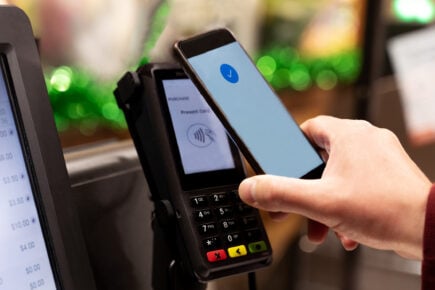
How Do I Pay With My Phone?
Instead of carrying your wallet around and pulling it out at check-out, you can just tap your phone, which is always on you, to pay for most things now.

What Is a Travel Credit Card?
Using a travel rewards credit card can help you get your next flight on a discount, hotel upgrades, or even cover the full cost of a trip.
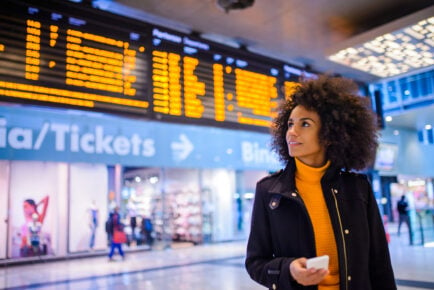
What Is a Frequent Flyer Program Credit Card?
Frequent flyer credit cards earn points or miles that can upgrade your travel and help you score free flights.

How To Lock, Block Or Freeze Your Credit Card
A card lock is essentially an on-off switch that allows you to temporarily freeze or block your credit card and most debit cards.
Travel money card
Spend like a local with a travel debit card for exploring the globe. Whether it's a virtual or a physical card, we've got all your travel money needs covered.
Need an international travel card? Take us all around the world
Exchange currencies, send money abroad, and hold 30+ local currencies in-app. These are just some of the reasons why our customers love their travel debit cards.
Built-in security features
Set spending limits, get payment notifications, and freeze or unfreeze your card in-app.
Add it to Google Pay or Apple Pay
No need to wait for your physical card to arrive — spend instantly with a virtual card.
No-fee ATM withdrawals
Get no-fee ATM withdrawals, up to A$1,400 per rolling month, depending on your plan type.¹
Manage travel money in-app
Manage everything for your holiday money card in the Revolut app, from top-ups to transfers.
Spend like a local in 100+ countries

No-fee ATM withdrawals, up to A$1,400 per month on Metal

Spend right away with Apple Pay or Google Pay

How to get your travel money card in Australia
Get your currency debit card in 3 steps
Get revolut.
Join 40+ million people worldwide saving when they spend abroad with Revolut.
Order your card
Order your travel money card to spend in 100+ countries.
Spend like a local
Start spending around the world. That's your travel money, sorted.
Get instant payment notifications

Trusted by travellers

Spend with confidence

Built-in security measures

How to save money with travel currency cards
Tips for saving money with a money travel card
Don't exchange at airports or at home.
Don’t exchange cash before you travel — use your travel money card to spend or withdraw money from an ATM (just watch out for ATM fees).
Always choose the local currency
Choose the local currency when spending with your card in shops and restaurants.
Save on travel spending with a Revolut card
Spend in the local currency at competitive rates on your next trip from Australia.
So much more than a travel money card
We're not a prepaid card you just throw away after your trip. Trust us, you’ll want to use Revolut for future adventures and everyday life.
Rating as of 22 Apr 2024
14K Reviews
2.8M Reviews
Spend your holiday money in 100+ countries
Need a little more help?
Holiday money card FAQs
What is a travel money card, what currencies can i spend in with a travel money card, what are the limits for spending with a travel card, how can i manage my travel money card, is a travel money card safe and secure, how can i order a travel money card.
- Download the Revolut app : find it in Apple or Google Play Store
- Sign up to Revolut : apply for an account and verify your identity
- Add a debit card : go to Cards and follow the instructions to start your order
- Set your PIN : choose a PIN that you'll remember
- Arrange delivery : enter your delivery address, and select your delivery method before proceeding to checkout (Delivery fees may apply)
Is a travel money card better than cash?
- Don’t exchange cash at the airport. It may be cheaper to withdraw money from an ATM with your travel money card.
- Don't carry more cash than you need. When you return home from your trip, you’ll need to re-convert this cash back to AUD, which can take time and cost you in fees.
- Always choose the local currency when spending with your card in shops and restaurants.
- Sign up to Revolut so you can manage your balance and get instant notifications on what you spend.
The content of this page is for general information purposes only and does not constitute financial advice. If you have any questions about your personal circumstances, please seek professional and independent advice. Revolut is not a financial adviser. ²Canstar 2023 Outstanding Value, Travel Money Card award received June 2023 for Standard and Premium accounts.
Currency Experts
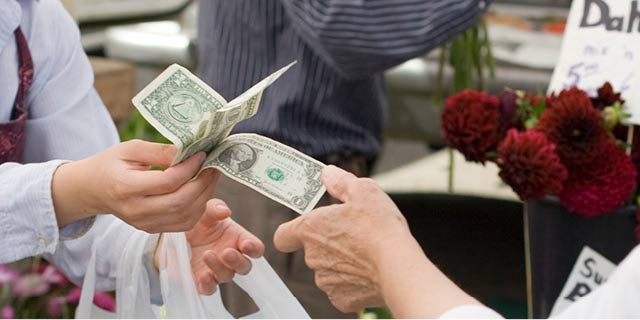
G - TMOZ - C&D Pizza Blog - Desktop Banner CTA (1).png

Why Travel Money
- Personal Finance
The journalists on the editorial team at Forbes Advisor Australia base their research and opinions on objective, independent information-gathering.
When covering investment and personal finance stories, we aim to inform our readers rather than recommend specific financial product or asset classes. While we may highlight certain positives of a financial product or asset class, there is no guarantee that readers will benefit from the product or investment approach and may, in fact, make a loss if they acquire the product or adopt the approach.
To the extent any recommendations or statements of opinion or fact made in a story may constitute financial advice, they constitute general information and not personal financial advice in any form. As such, any recommendations or statements do not take into account the financial circumstances, investment objectives, tax implications, or any specific requirements of readers.
Readers of our stories should not act on any recommendation without first taking appropriate steps to verify the information in the stories consulting their independent financial adviser in order to ascertain whether the recommendation (if any) is appropriate, having regard to their investment objectives, financial situation and particular needs. Providing access to our stories should not be construed as investment advice or a solicitation to buy or sell any security or product, or to engage in or refrain from engaging in any transaction by Forbes Advisor Australia. In comparing various financial products and services, we are unable to compare every provider in the market so our rankings do not constitute a comprehensive review of a particular sector. While we do go to great lengths to ensure our ranking criteria matches the concerns of consumers, we cannot guarantee that every relevant feature of a financial product will be reviewed. We make every effort to provide accurate and up-to-date information. However, Forbes Advisor Australia cannot guarantee the accuracy, completeness or timeliness of this website. Forbes Advisor Australia accepts no responsibility to update any person regarding any inaccuracy, omission or change in information in our stories or any other information made available to a person, nor any obligation to furnish the person with any further information.
Card Charges: What They Are, How They Work
Updated: Apr 16, 2024, 5:52am
Table of Contents
What are card charges, what’s the legal limit on card surcharge fees, who benefits from card charges, how to avoid the highest card charges, frequently asked questions (faqs).
Cash is no longer king when it comes to purchases in Australia, with just 13% of payments now made using physical money . With the rise of electronic payment methods, the average Aussie will make around 540 transactions annually using a credit or debit card.
While card charges on those transactions may be small—percentage-wise—the cumulative costs of fees can be in the hundreds each year. Learn more about how card charges work, where the money goes, and how you can pay less.
Some businesses absorb the costs of offering electronic payments into their overall product or service pricing—particularly larger retailers and grocery chains. But it’s also legal for businesses to add a surcharge to cover their costs when you pay with a credit, debit or prepaid card.
Surcharges are generally charged as a percentage of the purchase price, but it can also be a flat fee. Regardless of how a business applies it, by law the surcharge you pay should reflect the merchant’s actual costs to enable the transaction. The costs to a business to enable electronic payments will vary, depending on:
- The bank or payment processing provider they use;
- Whether the purchase is in-person or online; and
- The card network—e.g., eftpos, Mastercard, Visa.
Using a debit card in-person generally attracts the lowest transaction costs, especially if you insert or swipe your card rather than use a tap-and-go method or mobile wallet. That’s because most ‘contactless’ transactions are currently processed by Mastercard or Visa by default, which is more expensive than Eftpos.
Average Card Charges in Australia
The Reserve Bank of Australia says the average merchant costs for transactions in Australia are:
Debit cards
- 0.3% of the value for Eftpos transactions.
- 0.5% of the value for Mastercard and Visa transactions.
Credit cards
- 0.9% of the value for Mastercard and Visa transactions.
- 1.3% of the value for American Express transactions.
- 1.7% of the value for Diners Club transactions.
Businesses can’t legally charge excessive surcharge fees when you use eftpos, MasterCard or Visa payment methods. They need to abide by rules about how surcharges can be applied set out by the Australian Competition and Consumer Commission, such as:
- Businesses can only recoup their costs for offering a specific card payment type.
- The business must be able to prove the costs they used to calculate a surcharge.
- They need to display surcharge amounts in a prominent way.
In particular, if a business is cashless and your only payment option includes a surcharge—they need to explicitly include the surcharge dollar amount in their listed prices.
The ban on excessive surcharges does not apply to BPAY, PayPal, Diners Club, American Express cards issued directly by American Express, or taxi fares.
How To Complain About Excessive Card Surcharges
Unfortunately, not all businesses do the right thing. If you think you’ve been charged an excessive surcharge, you should first complain to the business directly to see if you can get satisfaction or at least an explanation of the cost.
If you want to escalate the matter, try your state’s fair trading agency or report to the ACCC .
Note the ACCC doesn’t intervene in individual disputes, but investigates business practices more broadly and can issue fines where breaches are identified. In 2019, Europcar was forced to pay $350,000 in penalties for charging excessive surcharge fees to more than 63,000 customers.
Card Charges Differ From Public Holiday Surcharges and Service Fees
It’s important to distinguish between card surcharges and general surcharges that businesses may charge on weekends or public holidays. Weekend and public holiday surcharges help your local cafe cover the extra cost of paying their staff penalty rates—and as long as these surcharges are prominently displayed to customers on the menu or on signage, they’re acceptable.
‘Service fees’ are more mysterious as they can cover a range of costs unique to a business, as long as they’re unrelated to payment costs. Keep in mind that businesses can set their pricing as they see fit, but the price shouldn’t be a surprise. All the costs you can expect to pay should be clearly and accurately conveyed at the start of the purchasing process.
Card networks get a cut of every electronic transaction, paid by both the bank that issued you your card, and the merchant’s bank. On top of the actual fees to access these networks, banks and other payment processors that work with merchants typically add a margin to cover their service costs and for things like providing point-of-sale devices and software.
Regardless of the underlying costs of transactions—whatever the merchant pays to access services is what’s used to determine surcharges you’ll pay when you buy using a card.
Australian payments industry expert Brad Kelly said some banks and other payment processors are “making a killing on merchant fees” as they’re able to cross-subsidise Visa and MasterCard transactions while accessing least-cost routing (LCR) across a higher volume of eftpos transactions.
LCR was introduced by the Reserve Bank of Australia after a review into payment regulation in 2019-20, in an effort to bring costs down for merchants. LCR gives merchants the choice to process contactless and online debit card transactions via the available card network that costs them the least to accept (with mobile wallets to be included in future).
The take up of LCR however, has been low—with little incentive for banks and other providers to promote it. Kelly says that instead of passing on savings to merchants, some providers offer comparatively high flat fees and keep the profits made on these low-cost transactions.
“Ultimately, the consumer pays through higher prices,” he said.
RBA Governor Michelle Bullock said in late 2023 that formal regulation may be needed to ensure banks and service providers “deliver the full benefits of LCR to businesses”. Bullock said the industry players “can all do a lot better” and she’d want to see around 80% of businesses with LCR enabled to avoid a mandate.
There are a few ways to reduce surcharge costs on your purchases, including:
- Paying with cash (provided you’re not paying ATM fees to withdraw your cash)
- Choosing to insert or swipe your card to access the eftpos network, rather than tap-and-go or using a digital wallet like Apple Pay or Google Pay.
- Prioritising businesses that don’t charge card surcharges.
Unfortunately, smaller businesses—like your local cafe or pub—are more likely to add a fee to electronic payments because they don’t have the economies of scale required to absorb all the costs of offering a wide range of payment methods for your convenience.
How much are card charges in Australia?
The RBA estimates the average for debit cards to be 0.3% of the value for Eftpos transactions; 0.5% of the value for Mastercard and Visa transactions. When it comes to credit cards, the average is 0.9% of the value for Mastercard and Visa transactions; 1.3% of the value for American Express transactions and 1.7% of the value for Diners Club transactions.
How can I avoid card surcharges?
The best way to avoid card surcharges is to leave them in your wallet and pay cash. If that is not convenient then Eftpos is the next best option—which means inserting your card rather than tapping—as Eptpos charges are the lowest form of surcharge with an average levy of .3%.
Australian Tax Brackets: 2023-2024
- Stage Three Tax Cuts
- Cost Of Living Guide
- Is The Australian Property Market Going To Crash?
- How Inflation Is Spreading To Uncharted Territory
- Australia’s Inflation Rate Reaches 7.4%
- Australian Property Market Update
- Interest Rates News
- Will Australia Go Into Recession?
- How High Will Interest Rates Go?
- Why is Australia’s inflation rate so high?
- How long can the Aussie jobs boom last?
- Australian property prices: how rate hikes hurt some more than others
- Six Scams To Watch Out For
- Will Interest Rates Go Down In 2024?
- Best Budgeting Apps
- Best Side Hustles
- How To Make Money Online
- What Is Monetary Policy?
- What Are Term Deposits and How Do They Work?
- What Causes Inflation?
- What Is The Minimum Wage In Australia?
- How Do Tax Deductions Work?
- Secured Loan Guide
- How To Check Your Credit Score In Australia
- How To Beat Electricity Price Rises
- How To Save Money As Cost Of Living Rises
- Are Electric Vehicles Worth It?
- How To Protect Yourself From Scams
- Cost Of Streaming Services In Australia
More from
Rent refugees from the inner cities: the great housing migration, australian inflation rate: rba eyes unemployment rate, interest rate news: cuts ‘may come in june’, australian property market: prices hit fresh highs, go west: why the sun is yet to set on perth’s economy.
Jody McDonald is a freelance writer based in Brisbane who specialises in writing about business, technology and the future of work. She’s helped a range of SaaS platforms and tech companies share their stories, and has written for the Mortgage and Finance Association of Australia magazine, MYOB Pulse, Anthill Magazine, Crypto News Australia and The Chainsaw.
Power up your money know-how
Join the 35K+ subscribers who receive our weekly Moneyzone newsletter, showcasing the latest rate movements, exclusive deals, money-saving hacks, and expert insights from Mozo.
Zero spam. Unsubscribe anytime.
By submitting your information you agree to the terms and conditions and privacy policy
Thanks for signing up
You will receive a welcome email shortly, mozo money moves: gap between investor and owner occupier rates narrows, are banks targeting investors.

Welcome back to another edition of Mozo Money Moves, your weekly banking wrap where we look at key changes to personal finance products, and review what’s been happening to interest rates, fees and conditions.
This week, National Australia Bank (NAB) cut advertised variable rates for some loans, which prompted Mozo to look a little deeper into the rates on offer for investors and owner occupiers, and it appears the gap between owner occupier rates and investor rates for borrowers paying principal and interest is narrowing.
Mozo also shared new research that showed the differences in cost between different travel money cards, to help Aussies save hundreds of dollars on their trips abroad this Winter by planning their spending method ahead before hopping on a plane.
Home Loan Moves
A few smaller lenders made changes to home loan rates this week, making adjustments to current offers, but no substantial moves from the bigger banks.
Notably on Monday, NAB cut interest rates between 0.78%-1.08% on its Tailored Home Loan offerings, marking the first variable rate cut by a Big Four Bank this year.
The cuts were applied to rates for both owner-occupiers and investors, paying principal and interest or interest-only, with a loan-to-value ratio (LVR) between 70-80%.
NAB's Tailored Home Loan now advertises a variable interest rate starting at 6.79% p.a. (6.87% p.a. comparison rate*) for owner occupier borrowers with a 70% LVR paying principal and interest, a drop 0.78% from its previously advertised rate.
Investors looking to secure a NAB home loan benefited from an even bigger drop in rates, with cuts of 1.08% to variable rates as low as 7.09% p.a. (7.17% p.a. comparison rate*) for those with an LVR of less than 70%.
“Mozo data shows there could well be a trend emerging in the home loan space, as the gap between investor home loan rate and owner occupier home loan rate averages for borrowers paying principal and interest is narrowing, ” said Mozo’s money expert Rachel Wastell.
“As interest only loans are high risk, these loans are priced higher for either borrower type, and as such there is very little difference between these advertised rates for owner occupiers and investors, but historically principal and interest loans for investors come with much higher rates.”
According to the Mozo database, in 2018, the gap between the average investor rate and owner occupier rates was roughly 50 basis points. However in the last quarter of 2021 that gap began to close, dropping below 45 basis points, to continue on a downward trend. The gap is now closer to 35 basis points.
Further, recent Lending Indicators data from the Australian Bureau of Statistics highlights a surge in lending to investors, rising by 21.5% over the past year, and accounting for over half total new loan commitment growth.
“It seems like the banks are adapting to an evolving property market, and this narrowing gap between investor and owner occupier home loan rates may be a strategic move by the banks to attract a growing cohort of property investors,” said Wastell.
Last week, the Commonwealth Bank also released data that suggested the younger generation were opting to invest when buying their first property, rather than buying a property to live in. According to the bank, 46% of its new property investors in 2023 were made up of millennials, and 37% were Gen z buyers.
"As property prices and rents continue to skyrocket, first home buyers who feel locked out of the market may be opting to rent-vest, rather than buying a home to live in, to get their foot on the property ladder,’ said Wastell.
“Buying a property at a lower cost in a less desirable area, and then renting it out, could be an opportunity for younger generations to become homeowners, and if the gap between investor rates and owner occupier rates continues to narrow, there could be some attractive rates on offer for prospective rent-vestors.”
Low Rate Investor Loans
*WARNING: This comparison rate applies only to the example or examples given. Different amounts and terms will result in different comparison rates. Costs such as redraw fees or early repayment fees, and cost savings such as fee waivers, are not included in the comparison rate but may influence the cost of the loan. The comparison rate displayed is for a secured loan with monthly principal and interest repayments for $150,000 over 25 years
Mozo Home Loan Insights:
- This week, NAB dropped interest rates on select home loans, with a cut of up to 1.08% now available to investors paying principal and interest.
- If you’ve been paying down your current home loan for a few years now, you could be in a position to score a better rate, here’s how.
- If you fall into negative equity, it can become a problem. So what is it exactly, and should you be concerned about it?
- Can you afford an $800,000 home? Here’s how much you’ll need.
Travel Money Moves
Mozo also released new data this week to help travellers preparing for trips abroad this Winter, urging them to carefully consider their choice of travel money card.
For travellers, travel money options beyond credit cards include debit cards, foreign currency accounts, and prepaid travel cards. As part of the Mozo Experts Choice Awards 2024 Mozo looked at exchange rates, conversion fees and overseas ATM fees to find that proactive planning could save Aussies hundreds of dollars.
Opting for a foreign currency account held the most substantial savings for travellers visiting the US, UK, or Europe, as they offered superior exchange rates, roughly 5% less than those charged on prepaid travel cards, and close to 1% less than everyday debit cards that use Visa and Mastercard exchange rates.
However, travellers should make sure that if they opt for an everyday debit card to fund their overseas travel, they should make sure they are not charged currency conversion fees or overseas ATM fees.
Travellers with everyday debit cards that do charge fees, could be paying $262 in conversion fees, based on the average currency conversion fee in the Mozo database of 2.62% and a $10,000 (AUD) balance. That doesn’t include the potential cost of overseas ATM fees, which cost $3.16 on average for every withdrawal you make.
"As the cost of living continues to rise, making informed decisions about the type of card you use on your trip has never been more crucial," explained Wastell.
"While most debit cards can provide competitive exchange rates, where travellers get burned is on high currency conversion fees and overseas ATM fees charges, which really add up over the course of a holiday. This is why it's so important to compare in advance."
Best Travel Money Cards
Travel money insights.
- Mozo money writer Jack Dona shares his own experience with the Wise foreign currency account and how it saved him money and kept it simple.
- When planning for a holiday most will think about where they want to go and how much it will cost, but travel insurance should also be top of mind .
- Thinking about taking a trip abroad this winter? Here’s where Aussies are travelling, and which destinations have the biggest insurance savings.
- If you can’t afford to go overseas, and are opting for a road trip increase, you’ll want to check these things before you jump in the car.
As a part of Mozo’s commitment to making your money count for more, each month we “roundup” the rate changes, key banking trends and money moves in the Australian personal finance market.
If you’d like to see the analysis in full once it’s released, you can subscribe to receive the Mozo Banking RoundUp here.
Disclaimer: Mozo provides general product information. We don't consider your personal objectives, financial situation or needs and we aren't recommending any specific product to you. You should make your own decision after reading the PDS or offer documentation, or seeking independent advice. Target Market Determinations can be found on the provider's website. While we pride ourselves on covering a wide range of products, we don't cover every product in the market. If you decide to apply for a product through our website, you will be dealing directly with the provider of that product and not with Mozo.
Who we are and how we get paid
Our goal at Mozo is to help you make smart financial decisions and our award-winning comparison tools and services are provided free of charge. As a marketplace business, we do earn money from advertising and this page features products with Go To Site links and/or other paid links where the provider pays us a fee if you go to their site from ours, or you take out a product with them. You do not pay any extra for using our service.
We are proud of the tools and information we provide and unlike some other comparison sites, we also include the option to search all the products in our database, regardless of whether we have a commercial relationship with the providers of those products or not.
'Sponsored', 'Hot deal' and 'Featured Product' labels denote products where the provider has paid to advertise more prominently.
'Mozo sort order' refers to the initial sort order and is not intended in any way to imply that particular products are better than others. You can easily change the sort order of the products displayed on the page.
Important information on terms, conditions and sub-limits
Terms, conditions, exclusions, limits and sub-limits may apply to any of the insurance products shown on the Mozo website. These terms, conditions, exclusions, limits and sub-limits could affect the level of benefits and cover available under any of the insurance products shown on the Mozo website. Please refer to the relevant Product Disclosure Statement and the Target Market Determination on the provider's website for further information before making any decisions about an insurance product.

3 Credit Card Mistakes to Avoid When You're Traveling
I t's common to take a credit card or two along with you when you travel. That way, you don't have to worry about running out of cash or struggling to find an ATM. But if you're going to use your credit cards while traveling, make certain to avoid these three big mistakes.
1. Not checking to see if there's a foreign transaction fee
It's not a given that your credit card will impose a foreign transaction fee. But some cards do. Always check the fine print before taking a credit card with you if you're traveling abroad, because in some cases, you may be looking at paying more than necessary for your purchases.
Featured offer: save money while you pay off debt with one of these top-rated balance transfer credit cards
Foreign transaction fees commonly amount to 1% to 3% of your purchase total. But let's say you go to Europe for a week and spend $1,000 on food and entertainment. With a 3% fee, you're looking at $30 extra.
If you have time between now and your next trip out of the country and none of your current credit cards are free from foreign transaction fees, consider applying for a new one. You may especially want to look at travel rewards credit cards , which often waive this fee and also tend to offer money-saving perks like discounts on in-flight purchases.
2. Not informing your credit card issuer that you'll be traveling
The fact that credit card companies are constantly on the lookout for fraud is a good thing. But you may run into some issues if you travel abroad or to another part of the country and you don't loop your credit card issuer in.
In that case, your card might get flagged for fraud and you may find that you're unable to use it. And while you can generally call your issuer to confirm that your charges are legitimate, thereby releasing that freeze, that hinges on you being able to place a call.
If you're abroad, you may not have an international calling plan. And if you're in a remote part of the U.S., you may not have reception. That could be a problem if you're trying to fill up your car on a country road, it's rejected at the only gas station within 80 miles, and you don't have cash.
3. Not keeping track of your credit card spending
When you're traveling, it's easy enough to spend more freely because you're in the midst of a whole new set of experiences. But don't let that spending get out of hand. If you don't track your purchases while traveling, you could end up with a costly pile of debt on your hands.
Let's say you've only budgeted for $1,000 worth of spending while on vacation outside of lodging and airfare, and your total purchases reach $1,600. That's a $600 balance you might have to pay off over six months. But on a credit card charging 20% interest, that'll mean paying an extra $35. That's money you could be putting toward a future trip instead.
A credit card can be an asset on your vacation. But do your best to avoid these mistakes, so you don't pay extra or end up having to deal with the hassle of having your credit card denied.
Alert: our top-rated cash back card now has 0% intro APR until 2025
This credit card is not just good – it’s so exceptional that our experts use it personally. It features a lengthy 0% intro APR period, a cash back rate of up to 5%, and all somehow for no annual fee! Click here to read our full review for free and apply in just 2 minutes.
We're firm believers in the Golden Rule, which is why editorial opinions are ours alone and have not been previously reviewed, approved, or endorsed by included advertisers. The Ascent does not cover all offers on the market. Editorial content from The Ascent is separate from The Motley Fool editorial content and is created by a different analyst team.The Motley Fool has a disclosure policy .
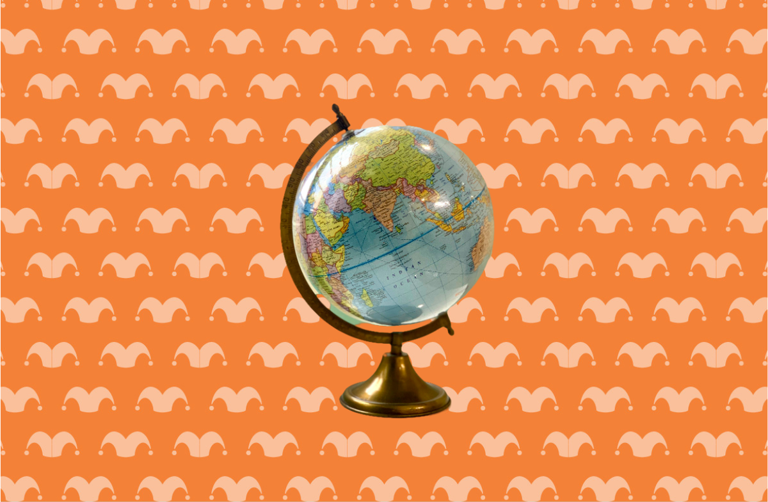
Are airlines making more money from frequent flyer programs than actually flying planes?
When it comes to the airline industry, most people would imagine that air travel is at the core of their business model.
It turns out frequent flyer or loyalty programs are equally as important to their business — and just as lucrative.
And there's no need to fly to participate.
In Australia, the Qantas Frequent Flyer program has more than 14 million members while the Velocity program run by Virgin Australia has more than 11 million members.
So Australians are clearly drawn to these frequent flyer clubs — but what exactly is in it for the consumer and are they really worth it?
How it all began
Up until the mid 1980s, the extent of Australian loyalty programs was generally a 'buy 10, get one free' coffee card or entertainment books filled with coupons.
But in the mid 1980s, things started to get more sophisticated.
Ganesh Sitarmaran, the author of Why Flying is Miserable and How to Fix it, tells ABC RN's The Money that there was a notable shift in frequent flyer programs when American airlines began partnering with banks to offer branded credit cards.
Shopping with these cards means gaining points that could then be used to redeem flights. It was a move that intrinsically linked airlines with banks.
Another major shift came in the 1990s when airlines started offering a range of fare classes beyond first class, business class or economy.
"So this meant that you had a lot more complexity to the structure of fares that were being offered," he says.
With varying fare prices, airlines quickly realised that loyalty programs needed to reward customers for the money they spent rather than the flights taken or the distance travelled.
And it was then, Mr Sitarmaran says, that airlines became more than just airlines.
"In a way, it turned airlines into something more like financial institutions."
Making something out of nothing
When banks create credit, they make it out of nothing. As Mr Sitarmaran explains, airlines are essentially doing the same thing with loyalty points.
"They take these points that they've created and they sell them for real money to banks with co-branded credit cards," he says.
Banks then charge customers annual credit card fees to access these co-branded cards, which accumulate points.
Yet the points sold to the bank are at zero cost to the airline until the points are redeemed, if ever.
"So valuable are the loyalty programs that some US airlines have been able to use the future earnings from them as collateral to borrow more money," Mr Sitarmaran explains.
"According to some analyses, airlines are making more money off of their mileage programs or their loyalty programs than they are from actually flying planes," he says.
With a broad spectrum of ways to earn and use points (that don't depend on flying), it shows how these schemes can help buffer airlines through financially turbulent periods, like the pandemic.
Mr Sitaraman says no one could've anticipated the scale and influence of these frequent flyer programs.
"I don't think the Wright brothers, when they invented the aeroplane in 1903, thought this is where we would end up."
Are there benefits for members?
Although airlines are making something out of nothing, Daniel Sciberras, editor-in-chief at Point Hacks, warns they have considerable power over their value when customers redeem them.
"Because they create them, they also decide how much this currency is worth," he says.
Therefore, if airlines increase the number of points required to take a flight or buy a particular product, Mr Sciberras says they can also devalue your points.
Another thing worth considering is data collection, says Choice consumer data advocate Kate Bower.
"Reward schemes work to gather data and then monetise that data," she says.
Choice is concerned that the relationships that airlines have with other companies is often opaque, so it's hard for consumers to know where their data might end up.
Philip Shelper, CEO of Loyalty and Reward Co, designs and implements loyalty programs for major brands.
He explains that the priorities of these programs is to keep customers coming back, boost brand advocacy and, most importantly, collect data.
"[The aim is to] make the experience of shopping with them a more personalised and more relevant one," Mr Shelper says.
However, Ms Bower argues that personalised marketing can disadvantage the consumer, as it can make it increasingly difficult to compare prices.
"To be able to get a fair comparison of price is something we should have in a fair market," she says.
Ms Bower says this is particularly relevant when it comes to airline pricing, given the dynamic pricing system. This is when prices change in response to real-time supply and demand.
Professor Leona Tam at UTS Business School suggests consumers stop regarding these schemes as frequent flyer programs and instead think of them as loyalty programs.
"Loyalty is basically a psychological commitment to a company or to a brand and often it would come with a superior view about how good a product or service is provided by this company," Professor Tam explains.
And companies should work for that loyalty.
Instead, for any company the cost to maintain an existing customer is far less than recruiting a new one, Professor Tam says.
"They want you to be on autopilot because in fact, they want you to put them as your top of mind every time you think about an airline," she says.
Professor Tam believes this loyalty is being tested with the current cost of living pressures.
"People are comparing more and coming into a more thoughtful decision-making process," she says.
"They are being tested big time."
How to benefit from these schemes
Mr Sciberras says there are two different aspects that consumers need to consider when signing up to loyalty programs.
"There's the earning points and then redeeming points — and you want to do both right," he says.
He says if customers are using a points-earning credit card, then the balance should be paid off in full each month.
"If you're going to get interest charged on your account, any benefit you get on the points is negated," he says.
If you do pay off your balance, he advises using that credit card for all purchases.
"Even your daily coffees, they all add up," he says.
Then, when it comes to using your points, make sure you know the program.
"Know the programs well to maximise the earning opportunities, but also know the best ways to redeem your points," he says.
He adds that using points on flights is usually better value rather redeeming those points for products.
So, is it worth it?
Mr Sciberras says every time a customer uses a points-linked credit card, the airline makes money from transaction fees.
He points out most people rationalise collecting points via their credit card because they would be making that purchase, such as grocery shopping, regardless so why not earn points while doing that?
But what it means for those who use cash is that they can be paying higher prices as transaction fees are often included into the cost of products.
And unfortunately you don't get a different price if you pay in cash.
"And so there's something quite regressive about the system as a whole," he says.
So it's hard to say whether the benefits outweigh the costs, particularly when it comes to data privacy, says Kate Bower from Choice.
"The majority of people will just sign up … tap and forget and they won't know where their data ends up or where it will end up in the future."
Editor's note, April 16, 2024: An earlier version of this story incorrectly implied two Australian airlines could be earning more from loyalty programs than flights. This version has been edited to be clarify the views expressed by the experts interviewed.
RN in your inbox
Get more stories that go beyond the news cycle with our weekly newsletter.
- X (formerly Twitter)
Related Stories
When it comes to real value, there's just one loyalty card worth keeping.
'Everyone else basically subsidises the smart people': The problem with frequent flyer points
How airlines make money from frequent fliers
- Air Transport Industry
- Consumer Confidence
- Melbourne Airport
- Sydney Airport
- Travel Preparation and Advice

IMAGES
VIDEO
COMMENTS
Canstar considers travel money cards from a range of providers. Our expert researchers use a sophisticated methodology to rank travel money cards based on their fees and features. We give the top-performing cards a 5-Star Rating. Some of the factors Canstar considers are:
Wise Travel Money Card. AUD,USD,CAD,EUR,GBP,JPY,NZD,SGD. 2 free ATM withdrawals per month up to AUD$350, then AUD$1.50 and 1.75% per withdrawal. $0. $0. Hold and spend funds in more than 40 ...
The ideal prepaid card for overseas travel. Buy online Manage your card Find Post Office. Travel smarter with our Australia Post Travel Platinum Mastercard, a reloadable, multi-currency prepaid card that's accepted wherever Mastercard is, worldwide 1. Easily swipe or tap in-store, use online and withdraw money from ATMs 2.
Here is a list of the 6 best prepaid cards you can take with you on your travels and the positives and negatives for each one: Wise - our pick for prepaid cards. Revolut - low fees. Citibank - good for use at home. Travelex - no fees for ATM withdrawals. Australia Post - lock in exchange rates. HSBC - no international transaction fees.
Australia Post Travel Platinum Mastercard. Available online or at post offices. Currencies: AUD, USD, NZD, EUR, GBP, SGD, THB, JPY, HKD, CAD, AED. Fees: Fee to reload the card via BPay, debit card or instore, but free via online bank transfer. Closure fee. Fees for ATM withdrawals in Australia and overseas.
7. Fiji. While the white sands and crystal blue waters of Fiji are a favourite for Aussie travellers, no prepaid travel cards currently support the Fijian dollar. However, as Mastercard and Visa ...
CommBank Travel Money Card is a convenient, simple and safe way to access your money when travelling overseas. ... (PDF) issued by Commonwealth Bank of Australia ABN 48 123 123 124 for Travel Money Card should be considered before making any decision about this product.
The four cards on test. We compared the four cards on the market: ANZ Travel Card. Commonwealth Bank Travel Money Card. American Express Global Travel Card. Travelex Cash Passport. Many outlets offer travel money cards that are just rebranded Travelex Cash Passport cards. We have not included them in this review.
You may buy or load money in up to 10 currencies at any one time and it can be easily managed online or via our Travelex Money App. From Australia, to the US, to Japan and the UK, the Travelex Money Card is the best travel money card for Europe, Asia, America and other continents. Receive great rates and no fees when buying or loading foreign ...
The Citibank Plus Everyday Account - bank debit card. With this card you can: withdraw money for free at over 3000 ATMs Australia-wide and overseas. take advantage of no foreign transaction fees, monthly fees, or minimum opening balance. transfer money to friends and family anywhere in the world for free.
Contact Mastercard Qantas Travel Money Global Support on 1300 825 302 (from within Australia), or +61 1300 825 302 (if overseas). If eligible, you can collect emergency funds from approved agent locations. The team will let you know the address details, telephone number and opening hours of the nearest agent location. Help & support.
Pre-paid travel money cards for Australia. With the Caxton FX Currency Mastercard you can pre-load your travel money and spend it in 15 currencies, including Norwegian Krone, South African rand and Swiss franc. There are no extra costs for ATM withdrawals or purchases, but a minimum of £50 or £100 needs to be loaded if using your mobile to ...
The Australia Post travel money card is a popular option for Australian travellers due to the convenience of stores. However we would recommend the Australia Post travel money card for paying in shops or accommodation as it is costly to withdraw cash from ATMS. As the Australia Post travel money card is fee heavy we recommend not making ...
01. Revolut — Best all-round travel card in Australia. 02. Wise — Best for number of currencies and foreign account details. 03. Considering going through your bank. 04. Compare the best travel cards in Australia. 05.
Wise - our pick for travel debit card for Australia. Wise accounts can hold and exchange 40+ currencies, and you can get a linked Wise card for a one time delivery fee. Top up your account in GBP and switch to AUD before you travel. All currency conversion uses the mid-market exchange rate, with low fees from 0.41%.
A prepaid travel money card is an easy, flexible and low-fee way to spend foreign currencies and keep your money safe while overseas. ... For example, Travelex and the Australia Post Travel ...
Travel money card. Spend like a local with a travel debit card for exploring the globe. Whether it's a virtual or a physical card, we've got all your travel money needs covered. Need an international travel card? Take us all around the world. Exchange currencies, send money abroad, and hold 30+ local currencies in-app.
If you find a better price, we'll guarantee to beat it. Compare exchange rates for 60+ foreign currencies. Use our currency calculator to work out how much you need in cash, or loaded on one of our travel money cards, for your overseas trip. When you're ready, order online or head to any of our 130+ stores Australia wide.
Using a credit card. Since credit cards are a common payment method in Australia, you may want to consider a travel credit card.The Capital One VentureOne Rewards Credit Card, for example, doesn't charge the normal foreign transaction fees, helping you keep more money in your wallet (Terms apply, see rates & fees).You could earn rewards on your purchases and get travel insurance, luggage ...
Qantas is hoping frequent flyers as well as infrequent flyers are willing to add a new card to their wallets with the impending launch of the Qantas Pay travel money card.. However, the new white Qantas Pay card is actually a rebranding of the Qantas Travel Money product - a prepaid multi-currency travel money card first known as Qantas Cash back in 2013.
Cash is no longer king when it comes to purchases in Australia, with just 13% of payments now made using physical money.With the rise of electronic payment methods, the average Aussie will make ...
For travellers, travel money options beyond credit cards include debit cards, foreign currency accounts, and prepaid travel cards. As part of the Mozo Experts Choice Awards 2024 Mozo looked at exchange rates, conversion fees and overseas ATM fees to find that proactive planning could save Aussies hundreds of dollars.
Featured offer: save money while you pay off debt with one of these top-rated balance transfer credit cards Foreign transaction fees commonly amount to 1% to 3% of your purchase total.
Up until the mid 1980s, the extent of Australian loyalty programs was generally a 'buy 10, get one free' coffee card or entertainment books filled with coupons. But in the mid 1980s, things ...